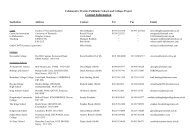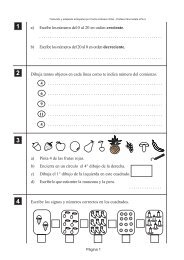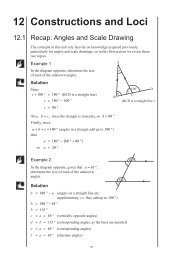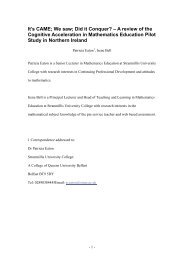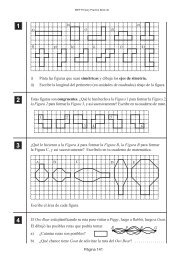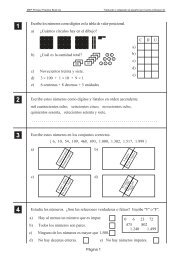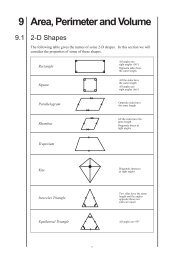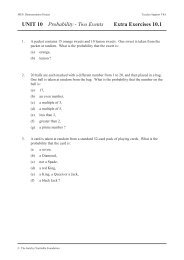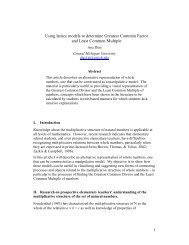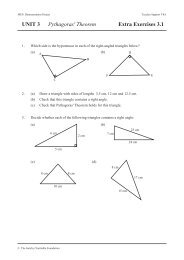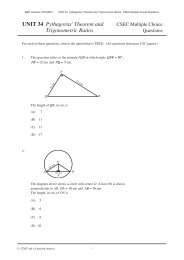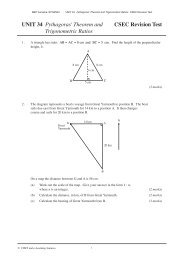An Analysis of Higher-Order Thinking on Algebra I End
An Analysis of Higher-Order Thinking on Algebra I End
An Analysis of Higher-Order Thinking on Algebra I End
Create successful ePaper yourself
Turn your PDF publications into a flip-book with our unique Google optimized e-Paper software.
ANALYSIS OF HIGHER-ORDER THINKING 1<br />
<str<strong>on</strong>g>An</str<strong>on</strong>g> <str<strong>on</strong>g>An</str<strong>on</strong>g>alysis <str<strong>on</strong>g>of</str<strong>on</strong>g> <str<strong>on</strong>g>Higher</str<strong>on</strong>g>-<str<strong>on</strong>g>Order</str<strong>on</strong>g> <str<strong>on</strong>g>Thinking</str<strong>on</strong>g> <strong>on</strong> <strong>Algebra</strong> I <strong>End</strong>-<str<strong>on</strong>g>of</str<strong>on</strong>g> Course Tests<br />
T<strong>on</strong>y Thomps<strong>on</strong><br />
Department <str<strong>on</strong>g>of</str<strong>on</strong>g> Mathematics, Science, and Instructi<strong>on</strong>al Technology Educati<strong>on</strong><br />
College <str<strong>on</strong>g>of</str<strong>on</strong>g> Educati<strong>on</strong>, East Carolina University, Greenville, NC 27858<br />
(252) 328-9358; thomps<strong>on</strong>an@ecu.edu<br />
ABSTRACT. This research provides insight into <strong>on</strong>e US state‘s effort to incorporate higher-<br />
order thinking <strong>on</strong> its <strong>Algebra</strong> I <strong>End</strong>-<str<strong>on</strong>g>of</str<strong>on</strong>g>-Course tests. To facilitate the inclusi<strong>on</strong> <str<strong>on</strong>g>of</str<strong>on</strong>g> higher-order<br />
thinking, the state used Dimensi<strong>on</strong>s <str<strong>on</strong>g>of</str<strong>on</strong>g> <str<strong>on</strong>g>Thinking</str<strong>on</strong>g> (Marzano et al., 1988) and Bloom’s Tax<strong>on</strong>omy<br />
(Bloom et al., 1956). <str<strong>on</strong>g>An</str<strong>on</strong>g> analysis <str<strong>on</strong>g>of</str<strong>on</strong>g> <strong>Algebra</strong> I test items found that the state‘s initial<br />
interpretati<strong>on</strong> and applicati<strong>on</strong> <str<strong>on</strong>g>of</str<strong>on</strong>g> Dimensi<strong>on</strong>s <str<strong>on</strong>g>of</str<strong>on</strong>g> <str<strong>on</strong>g>Thinking</str<strong>on</strong>g> and Bloom’s Tax<strong>on</strong>omy was faulty and<br />
inc<strong>on</strong>sistent; as a result, few <strong>Algebra</strong> I test items from 1998 and 2001 were found to assess<br />
higher-order thinking. <strong>Algebra</strong> I test items written in 2007 were found to be more cognitively<br />
complex. This case study provides several findings that other test item writers (whether for the<br />
classroom or large-scale assessments) can apply to their own situati<strong>on</strong> regarding assessing for<br />
higher-order thinking. These includes the importance <str<strong>on</strong>g>of</str<strong>on</strong>g>: (a) c<strong>on</strong>sidering the ―familiarity‖ a<br />
student has with a test item in deciding whether the item is lower- or higher-order thinking; (b)<br />
using a mathematics specific assessment framework with a limited number <str<strong>on</strong>g>of</str<strong>on</strong>g> categories; and (c)<br />
not c<strong>on</strong>fusing test items placed in a ―real-world‖ c<strong>on</strong>text with higher-order thinking.<br />
Keywords: higher-order thinking, large-scale assessment, algebra, Bloom’s Tax<strong>on</strong>omy,<br />
Dimensi<strong>on</strong>s <str<strong>on</strong>g>of</str<strong>on</strong>g> <str<strong>on</strong>g>Thinking</str<strong>on</strong>g>, assessment frameworks
ANALYSIS OF HIGHER-ORDER THINKING 2<br />
<str<strong>on</strong>g>An</str<strong>on</strong>g> analysis <str<strong>on</strong>g>of</str<strong>on</strong>g> higher-order thinking <strong>on</strong> <strong>Algebra</strong> I <strong>End</strong>-<str<strong>on</strong>g>of</str<strong>on</strong>g> Course tests<br />
The ability to think at higher levels is c<strong>on</strong>sidered a major instructi<strong>on</strong>al goal <str<strong>on</strong>g>of</str<strong>on</strong>g> educati<strong>on</strong> and<br />
a driving force behind efforts to reform mathematics educati<strong>on</strong> over the past twenty years (Costa,<br />
2001; De B<strong>on</strong>o, 1994; D<strong>on</strong>ovan & Bransford, 2005; Hiebert et al., 1997; Kulm, 1990; Lubezky,<br />
Dori, & Zoller, 2004; Nati<strong>on</strong>al Council <str<strong>on</strong>g>of</str<strong>on</strong>g> Teachers <str<strong>on</strong>g>of</str<strong>on</strong>g> Mathematics, 1989; 2000; Nati<strong>on</strong>al<br />
Research Council, 2001; Resnick, 1987; Stein, Grove, & Henningsen, 1996). However, teaching<br />
for higher-order thinking (HOT) is difficult, and some US educators are c<strong>on</strong>cerned that state<br />
testing makes teaching for HOT even more challenging (Barksdale-Ladd & Thomas, 2000; J<strong>on</strong>es<br />
et al., 1999; J<strong>on</strong>es, J<strong>on</strong>es, & Hargrove, 2003; Kohn, 2000; McNeil, 2000; Neill, 2003; Ravitch,<br />
2010; Smith, 1991; Smith & Rottenberg, 1991). Their argument is that many US state exams<br />
primarily focus <strong>on</strong> lower-order thinking (LOT) (e.g., procedural skills; symbol manipulati<strong>on</strong>) at<br />
the expense <str<strong>on</strong>g>of</str<strong>on</strong>g> HOT (e.g., problem solving; reas<strong>on</strong>ing).<br />
According to the Nati<strong>on</strong>al Center for Educati<strong>on</strong> Statistics (1996), teaching for HOT al<strong>on</strong>g<br />
with pr<str<strong>on</strong>g>of</str<strong>on</strong>g>essi<strong>on</strong>al development in HOT were found to be two <str<strong>on</strong>g>of</str<strong>on</strong>g> the top five variables positively<br />
associated with improved student achievement. Students <str<strong>on</strong>g>of</str<strong>on</strong>g> teachers who teach for both LOT and<br />
HOT outperform students whose teachers <strong>on</strong>ly teach for LOT (Wenglinsky, 2002). However,<br />
nati<strong>on</strong>al and internati<strong>on</strong>al assessments in mathematics (e.g., Trends in Mathematics and Science<br />
Study [TIMSS], Programme for Internati<strong>on</strong>al Student Assessment [PISA], and Nati<strong>on</strong>al<br />
Assessment <str<strong>on</strong>g>of</str<strong>on</strong>g> Educati<strong>on</strong>al Progress [NAEP]) indicate that the US educati<strong>on</strong>al system is not<br />
preparing students to solve complex problems, or in general, to think at higher levels (Baldi, Jin,<br />
Green, Herget, & Xie, 2007; Kloosterman, 2010; Lee, Grigg, Di<strong>on</strong>, 2007; Mullis, Martin, & Foy,<br />
2008). The poor performance <str<strong>on</strong>g>of</str<strong>on</strong>g> US students <strong>on</strong> nati<strong>on</strong>al and internati<strong>on</strong>al exams reflects<br />
research findings which indicate that most US teachers find it difficult to teach and assess for
ANALYSIS OF HIGHER-ORDER THINKING 3<br />
HOT (Kulm, 1990; Senk, Beckman, & Thomps<strong>on</strong>, 1997, Silver et al., 2009). However, the<br />
ability to engage in high-level reas<strong>on</strong>ing in mathematics is necessary for the 21 st century<br />
workplace including the development <str<strong>on</strong>g>of</str<strong>on</strong>g> future scientists, engineers, and mathematicians<br />
(Partnership for 21 st Century Skills, 2008).<br />
Many US states claim to have created standards that are challenging and meet the goal <str<strong>on</strong>g>of</str<strong>on</strong>g><br />
teaching for HOT; however, corresp<strong>on</strong>ding state exams designed to measure these standards<br />
<str<strong>on</strong>g>of</str<strong>on</strong>g>ten assess mostly lower levels <str<strong>on</strong>g>of</str<strong>on</strong>g> thinking (Lane, 2004; Nichols & Sugrue, 1999; Resnick,<br />
Rothman, Slattery, & Vranek, 2003; Webb, 1999; 2002; 2007). As Resnick et al. (2003) noted<br />
regarding their analysis <str<strong>on</strong>g>of</str<strong>on</strong>g> several US state exams, ―it is … easier to test the simplest knowledge<br />
and skills … leaving complex c<strong>on</strong>cepts, extending reas<strong>on</strong>ing, and other higher-level cognitive<br />
demands underrepresented <strong>on</strong> the test‖ (p. 6).<br />
US state exams help define what c<strong>on</strong>tent is important and have been shown to play a role in<br />
influencing teachers‘ classroom practices (Pedulla, Abrams, Madaus, Russell, Ramos & Miao,<br />
2003). In many cases, teachers will <str<strong>on</strong>g>of</str<strong>on</strong>g>ten write their own tests to reflect the specific c<strong>on</strong>tent and<br />
format <str<strong>on</strong>g>of</str<strong>on</strong>g> their state tests (Corbett & Wils<strong>on</strong>, 1991; Madaus, West, Harm<strong>on</strong>, Lomax, & Viator,<br />
1992; McMillan, Myran, & Workman 1999; Smith, 1991). It is within this c<strong>on</strong>text that some<br />
educators propose that if state tests can successfully focus <strong>on</strong> HOT, then it will encourage and<br />
assist teachers to teach for HOT in their classrooms (Kulm, 1990; Yeh, 2001; Popham, 1987;<br />
Tankersley, 2007; Wiggins, 1993). From this point <str<strong>on</strong>g>of</str<strong>on</strong>g> view, the development <str<strong>on</strong>g>of</str<strong>on</strong>g> state<br />
examinati<strong>on</strong>s that assess higher-order thinking is key to facilitating the development <str<strong>on</strong>g>of</str<strong>on</strong>g> HOT by<br />
all students (Zoller & Tsaparlis, 1997). There is evidence to support this view; for those states<br />
that have exams that include problem solving and open-ended tasks (i.e., HOT), teachers report
ANALYSIS OF HIGHER-ORDER THINKING 4<br />
using more tasks in the classroom similar to those <strong>on</strong> the test (Pedulla et al., 2003; Stecher,<br />
Barr<strong>on</strong>, Chun, & Ross, 2000).<br />
Since large-scale assessments (such as state exams) play an important role in what teachers<br />
teach and students learn, it is important to take a critical look at US state testing programs.<br />
(Clarke et al., 2003; Lane, 2004, Webb, 1999; 2002; 2007) In particular, it is important to<br />
ascertain whether or not the cognitive skills they claim to assess are actually included <strong>on</strong> the<br />
exams (McMillan, Myran, & Workman, 1999). Since the 1990s, <strong>on</strong>e US state, North Carolina,<br />
has used the thinking skills from Dimensi<strong>on</strong>s <str<strong>on</strong>g>of</str<strong>on</strong>g> <str<strong>on</strong>g>Thinking</str<strong>on</strong>g> (Marzano et al., 1988) as a framework<br />
to develop items for its <strong>End</strong>-<str<strong>on</strong>g>of</str<strong>on</strong>g>-Course (EOC) tests (North Carolina Department <str<strong>on</strong>g>of</str<strong>on</strong>g> Public<br />
Instructi<strong>on</strong> [NC DPI], 1999). The NC DPI (1996) chose to classify test items using Dimensi<strong>on</strong>s<br />
<str<strong>on</strong>g>of</str<strong>on</strong>g> <str<strong>on</strong>g>Thinking</str<strong>on</strong>g> because it allowed them to better assess:<br />
… the mastery <str<strong>on</strong>g>of</str<strong>on</strong>g> higher level skills. The term ―higher level skills‖ refers to the thinking<br />
and problem solving strategies that enable people to access, sort, and digest enormous<br />
amounts <str<strong>on</strong>g>of</str<strong>on</strong>g> informati<strong>on</strong>. It refers to the skills required to solve complex problems and to<br />
make informed choices and decisi<strong>on</strong>s. (p. 1)<br />
More specifically, Dimensi<strong>on</strong>s <str<strong>on</strong>g>of</str<strong>on</strong>g> <str<strong>on</strong>g>Thinking</str<strong>on</strong>g> was used <strong>on</strong> the mathematics EOC tests to help:<br />
… focus <strong>on</strong> problem solving and assesses a student‘s ability to apply mathematical<br />
principles, solve problems, and explain mathematical processes. Problems are typically<br />
posed as real situati<strong>on</strong>s that students may have encountered, but are not always simple in<br />
nature (e.g., quadratic or exp<strong>on</strong>ential functi<strong>on</strong>s in science). (NC DPI, 1998, p. 4)<br />
The NC DPI made two modificati<strong>on</strong>s to Dimensi<strong>on</strong>s <str<strong>on</strong>g>of</str<strong>on</strong>g> <str<strong>on</strong>g>Thinking</str<strong>on</strong>g>. First, Dimensi<strong>on</strong>s <str<strong>on</strong>g>of</str<strong>on</strong>g><br />
<str<strong>on</strong>g>Thinking</str<strong>on</strong>g> has eight thinking skills: focusing, informati<strong>on</strong> gathering, remembering, organizing,<br />
analyzing, generating, integrating, and evaluating. The NC DPI collapsed the first three<br />
categories – focusing, informati<strong>on</strong> gathering, and remembering – to a category called knowledge.<br />
Sec<strong>on</strong>d, the NC DPI added a thinking skill called applying not found in Dimensi<strong>on</strong>s <str<strong>on</strong>g>of</str<strong>on</strong>g> <str<strong>on</strong>g>Thinking</str<strong>on</strong>g>.
ANALYSIS OF HIGHER-ORDER THINKING 5<br />
According to NC DPI <str<strong>on</strong>g>of</str<strong>on</strong>g>ficials, applying is defined to be c<strong>on</strong>sistent with applicati<strong>on</strong> in Bloom’s<br />
Tax<strong>on</strong>omy (Bloom, Engelhart, Furst, Hill, & Krathwohl, 1956).<br />
Below is a summary <str<strong>on</strong>g>of</str<strong>on</strong>g> the modified versi<strong>on</strong> <str<strong>on</strong>g>of</str<strong>on</strong>g> Dimensi<strong>on</strong>s <str<strong>on</strong>g>of</str<strong>on</strong>g> <str<strong>on</strong>g>Thinking</str<strong>on</strong>g> thinking skills that<br />
the NC DPI (1999) used to classify items in its EOC tests:<br />
―Knowledge: using focusing skills, informati<strong>on</strong>-gathering skills, and remembering skills.<br />
Organizing: arranging informati<strong>on</strong> so it can be used effectively; noting similarities and<br />
differences between or am<strong>on</strong>g entities; grouping and labeling entities <strong>on</strong> the basis <str<strong>on</strong>g>of</str<strong>on</strong>g> their<br />
attributes; sequencing entities according to a given criteria; changing the form but not the<br />
substance <str<strong>on</strong>g>of</str<strong>on</strong>g> informati<strong>on</strong>.<br />
Applying: dem<strong>on</strong>strating prior knowledge within a new situati<strong>on</strong>. The task is to bring<br />
together the appropriate informati<strong>on</strong>, generalizati<strong>on</strong>s or principles that are required to<br />
solve a problem.<br />
<str<strong>on</strong>g>An</str<strong>on</strong>g>alyzing: clarifying existing informati<strong>on</strong> by examining parts and relati<strong>on</strong>ships;<br />
identifying attributes and comp<strong>on</strong>ents; identifying relati<strong>on</strong>ships and patterns; identifying<br />
errors.<br />
Generating: producing new informati<strong>on</strong>, meaning, or ideas, going bey<strong>on</strong>d available<br />
informati<strong>on</strong> to identify what reas<strong>on</strong>ably may be true; anticipating next events, or the<br />
outcome <str<strong>on</strong>g>of</str<strong>on</strong>g> a situati<strong>on</strong>; explaining by adding details, examples, or other relevant<br />
informati<strong>on</strong><br />
Integrating: combining informati<strong>on</strong> efficiently into a cohesive statement and changing<br />
existing knowledge structures to incorporate new informati<strong>on</strong>.<br />
Evaluating: assessing the reas<strong>on</strong>ableness and quality <str<strong>on</strong>g>of</str<strong>on</strong>g> ideas; creating standards for<br />
making judgments; c<strong>on</strong>firming the accuracy <str<strong>on</strong>g>of</str<strong>on</strong>g> claims.‖ (p. 2)<br />
According to an NC DPI mathematics specialist, the thinking skills <str<strong>on</strong>g>of</str<strong>on</strong>g> knowledge, organizing<br />
and applying are c<strong>on</strong>sidered LOT while analyzing, generating, integrating, and evaluating are<br />
c<strong>on</strong>sidered HOT.<br />
Purpose <str<strong>on</strong>g>of</str<strong>on</strong>g> the study<br />
It is important to investigate the extent to which assessment items <strong>on</strong> US state exams are<br />
eliciting HOT (Lane, 2004; Messick, 1989; Tankersley, 2007). In their research <strong>on</strong> US state<br />
assessments, Webb (1999; 2002; 2007) and Resnick et al. (2003) found that some states do a<br />
better job than others in assessing HOT. However, their research reports <strong>on</strong> these state
ANALYSIS OF HIGHER-ORDER THINKING 6<br />
assessments provided an<strong>on</strong>ymity to the states and specific test items are not shared. This is due<br />
to their decisi<strong>on</strong> to analyze secured state exams that were in use at the time <str<strong>on</strong>g>of</str<strong>on</strong>g> their research.<br />
However, this prevented the researchers from sharing test items to use as examples in order to<br />
support their c<strong>on</strong>clusi<strong>on</strong>s. Keeping states an<strong>on</strong>ymous and not including test items in research<br />
studies makes it difficult for the educati<strong>on</strong> community and public-at-large to independently<br />
verify the c<strong>on</strong>clusi<strong>on</strong>s or to gain deeper insight into testing for HOT.<br />
The purpose <str<strong>on</strong>g>of</str<strong>on</strong>g> this research was to investigate how <strong>on</strong>e US state, North Carolina, used<br />
Dimensi<strong>on</strong>s <str<strong>on</strong>g>of</str<strong>on</strong>g> <str<strong>on</strong>g>Thinking</str<strong>on</strong>g> and Bloom’s Tax<strong>on</strong>omy to classify items for its <strong>Algebra</strong> I EOC tests in<br />
1998, 2001, and 2007. In the US, <strong>Algebra</strong> I is generally taken by students in the 8 th or 9 th grade.<br />
Approaching this research from an historical perspective allows the researcher to use released<br />
items from <strong>Algebra</strong> I EOC tests for analysis that can be shared with readers. This provides<br />
others the opportunity to verify or challenge the c<strong>on</strong>clusi<strong>on</strong>s presented in this research. The<br />
specific research questi<strong>on</strong>s guiding this study were:<br />
(1) How did the North Carolina Department <str<strong>on</strong>g>of</str<strong>on</strong>g> Public Instructi<strong>on</strong> (NC DPI) use Dimensi<strong>on</strong>s<br />
<str<strong>on</strong>g>of</str<strong>on</strong>g> <str<strong>on</strong>g>Thinking</str<strong>on</strong>g> and Bloom’s Tax<strong>on</strong>omy to categorize thinking skills for <strong>Algebra</strong> I <strong>End</strong>-<str<strong>on</strong>g>of</str<strong>on</strong>g>-<br />
Course (EOC) test items in 1998, 2001 and 2007?<br />
(2) Did the NC DPI‘s use <str<strong>on</strong>g>of</str<strong>on</strong>g> Dimensi<strong>on</strong>s <str<strong>on</strong>g>of</str<strong>on</strong>g> <str<strong>on</strong>g>Thinking</str<strong>on</strong>g> and Bloom’s Tax<strong>on</strong>omy result in the<br />
creati<strong>on</strong> <str<strong>on</strong>g>of</str<strong>on</strong>g> <strong>Algebra</strong> I EOC test items that were likely to assess higher-order thinking?<br />
Defining higher-order thinking<br />
<str<strong>on</strong>g>Thinking</str<strong>on</strong>g> skills resist precise forms <str<strong>on</strong>g>of</str<strong>on</strong>g> definiti<strong>on</strong>, but as Resnick (1987) and Marzano et al.<br />
(1988) noted, lower-order thinking (LOT) and higher-order thinking (HOT) can be recognized<br />
when each occurs. In the research literature, LOT is <str<strong>on</strong>g>of</str<strong>on</strong>g>ten characterized as the recall <str<strong>on</strong>g>of</str<strong>on</strong>g><br />
informati<strong>on</strong> or the applicati<strong>on</strong> <str<strong>on</strong>g>of</str<strong>on</strong>g> c<strong>on</strong>cepts or knowledge to familiar situati<strong>on</strong>s and c<strong>on</strong>texts.<br />
Schmalz (1973) noted that LOT tasks requires a student ―… to recall a fact, perform a simple<br />
operati<strong>on</strong>, or solve a familiar type <str<strong>on</strong>g>of</str<strong>on</strong>g> problem; it does not require the student to work outside the
ANALYSIS OF HIGHER-ORDER THINKING 7<br />
familiar‖ (p. 619). Senk et al. (1997) characterized LOT as solving tasks where the soluti<strong>on</strong><br />
requires applying a well-known algorithm, <str<strong>on</strong>g>of</str<strong>on</strong>g>ten with no justificati<strong>on</strong>, explanati<strong>on</strong>, or pro<str<strong>on</strong>g>of</str<strong>on</strong>g><br />
required, and where <strong>on</strong>ly a single correct answer is possible. In general, LOT is characterized as<br />
solving tasks while working in familiar situati<strong>on</strong>s and c<strong>on</strong>texts; or, applying well-known<br />
algorithms familiar to the students.<br />
In c<strong>on</strong>trast, Resnick (1987) characterized HOT as requiring nuanced judgment and being<br />
n<strong>on</strong>-algorithmic; i.e., where the ―path <str<strong>on</strong>g>of</str<strong>on</strong>g> acti<strong>on</strong> … [is] not fully specified in advance‖ (p. 44).<br />
Similarly, Stein and Lane (1996) describe HOT as ―the use <str<strong>on</strong>g>of</str<strong>on</strong>g> complex, n<strong>on</strong>-algorithmic thinking<br />
to solve a task in which there is not a predictable, well-rehearsed approach or pathway explicitly<br />
suggested by the task, task instructi<strong>on</strong>, or a worked out example‖ (p. 58). Senk et al. (1997)<br />
characterized HOT as solving tasks where no algorithm has been taught, where justificati<strong>on</strong> or<br />
explanati<strong>on</strong> are required, and where more than <strong>on</strong>e soluti<strong>on</strong> may be possible. The Nati<strong>on</strong>al<br />
Council <str<strong>on</strong>g>of</str<strong>on</strong>g> Teachers <str<strong>on</strong>g>of</str<strong>on</strong>g> Mathematics (NCTM, 1989) characterizes higher-order thinking as<br />
solving a n<strong>on</strong>-routine problem. That is, a problem involving ―a situati<strong>on</strong> in which, for the<br />
individual or group c<strong>on</strong>cerned, <strong>on</strong>e or more appropriate soluti<strong>on</strong>s have yet to be developed‖ (p.<br />
10). In mathematics, what distinguishes a n<strong>on</strong>-routine problem from a routine problem (or<br />
exercise) is whether the student already knows an algorithm that, when applied, will lead to a<br />
soluti<strong>on</strong> (Charles & Lester, 1982; Kantowski, 1977). In general, HOT involves solving tasks<br />
where an algorithm has not been taught or using known algorithms while working in unfamiliar<br />
c<strong>on</strong>texts or situati<strong>on</strong>s.<br />
Despite the challenge <str<strong>on</strong>g>of</str<strong>on</strong>g> defining HOT, this research required a definiti<strong>on</strong> <str<strong>on</strong>g>of</str<strong>on</strong>g> HOT in order<br />
to evaluate <strong>Algebra</strong> I EOC test items. The main differences between LOT and HOT as described<br />
in the literature is the familiarity a student has to a task and whether the student already knows an
ANALYSIS OF HIGHER-ORDER THINKING 8<br />
algorithm or soluti<strong>on</strong> strategy that, when used properly, will lead to a correct soluti<strong>on</strong>. Therefore,<br />
for this research project, the definiti<strong>on</strong> <str<strong>on</strong>g>of</str<strong>on</strong>g> Stein and Lane (1996) was used since it is specific to<br />
mathematics and encapsulates most descripti<strong>on</strong>s <str<strong>on</strong>g>of</str<strong>on</strong>g> HOT found in the literature: A test item was<br />
identified by the researcher as requiring higher-order thinking if—from the students‘<br />
perspective—it requires ―the use <str<strong>on</strong>g>of</str<strong>on</strong>g> complex, n<strong>on</strong>-algorithmic thinking to solve a task in which<br />
there is not a predictable, well-rehearsed approach or pathway explicitly suggested by the task,<br />
task instructi<strong>on</strong>, or a worked out example‖ (p. 58). It is important to note that the definiti<strong>on</strong> <str<strong>on</strong>g>of</str<strong>on</strong>g><br />
HOT used by this researcher is not the definiti<strong>on</strong> <str<strong>on</strong>g>of</str<strong>on</strong>g> HOT used by NC DPI in the creati<strong>on</strong> <str<strong>on</strong>g>of</str<strong>on</strong>g> test<br />
items. According to NC DPI <str<strong>on</strong>g>of</str<strong>on</strong>g>ficials, HOT is characterized as the thinking skills <str<strong>on</strong>g>of</str<strong>on</strong>g> analyzing,<br />
integrating, generating, and evaluating as defined in Dimensi<strong>on</strong>s <str<strong>on</strong>g>of</str<strong>on</strong>g> <str<strong>on</strong>g>Thinking</str<strong>on</strong>g>.<br />
Methods<br />
Many <str<strong>on</strong>g>of</str<strong>on</strong>g> the test items used in this research al<strong>on</strong>g with the corresp<strong>on</strong>ding thinking skills<br />
each item was designed to measure are available to the public <strong>on</strong> the NC DPI website<br />
(http://www.ncpublicschools.org/accountability/testing/eoc/). Seventy test items based <strong>on</strong> the<br />
1998 Standard Course <str<strong>on</strong>g>of</str<strong>on</strong>g> Study (for academic year 2000-2001) and 72 test items from the 2003<br />
Standard Course <str<strong>on</strong>g>of</str<strong>on</strong>g> Study (for academic year 2006-2007) were available to be downloaded for<br />
analysis. There were no 1998 <strong>Algebra</strong> I EOC test items (based <strong>on</strong> the 1993 Standard Course <str<strong>on</strong>g>of</str<strong>on</strong>g><br />
Study) available <strong>on</strong>line; however, the researcher obtained two 1998 <strong>Algebra</strong> I <strong>End</strong>-<str<strong>on</strong>g>of</str<strong>on</strong>g>-Course<br />
tests (Forms S and T) from NC DPI. Each 1998 EOC test c<strong>on</strong>sisted <str<strong>on</strong>g>of</str<strong>on</strong>g> 81 items for a total <str<strong>on</strong>g>of</str<strong>on</strong>g> 304<br />
<strong>Algebra</strong> I EOC test items.<br />
For inter-rater reliability, a doctoral graduate assistant (who was a former sec<strong>on</strong>dary<br />
mathematics teacher) also classified test items. To assist in categorizing test items the following<br />
materials were used as references:
ANALYSIS OF HIGHER-ORDER THINKING 9<br />
The modified Dimensi<strong>on</strong>s <str<strong>on</strong>g>of</str<strong>on</strong>g> <str<strong>on</strong>g>Thinking</str<strong>on</strong>g> framework materials published by NC DPI (1999)<br />
Dimensi<strong>on</strong>s <str<strong>on</strong>g>of</str<strong>on</strong>g> <str<strong>on</strong>g>Thinking</str<strong>on</strong>g> (Marzano et al., 1988)<br />
Tax<strong>on</strong>omy <str<strong>on</strong>g>of</str<strong>on</strong>g> educati<strong>on</strong>al objectives: Part I, cognitive domain (Bloom et al., 1956)<br />
Handbook <strong>on</strong> formative and summative evaluati<strong>on</strong> <str<strong>on</strong>g>of</str<strong>on</strong>g> student learning (Bloom, Hasting,<br />
& Madaus, 1971)<br />
Bloom‘s books were also used since the NC DPI framework included applying based <strong>on</strong><br />
applicati<strong>on</strong> in Bloom’s Tax<strong>on</strong>omy. In additi<strong>on</strong>, textbooks used by <strong>Algebra</strong> I teachers in North<br />
Carolina were c<strong>on</strong>sulted to determine the types <str<strong>on</strong>g>of</str<strong>on</strong>g> tasks students were likely to have been taught<br />
during <strong>Algebra</strong> I.<br />
In March 2010, all 304 <strong>Algebra</strong> I test items from 1998, 2001, and 2007 were categorized<br />
using the definiti<strong>on</strong>s <str<strong>on</strong>g>of</str<strong>on</strong>g> LOT and HOT (Stein & Lane, 1996). The inter-rater reliability for<br />
categorizing the test items was 89%. According to Kaid and Wadsworth (1989), researchers can<br />
generally be satisfied with inter-reliability greater than 85%. Items for which the raters disagreed<br />
were resolved in NC DPI‘s favor. In May 2010, all 304 <strong>Algebra</strong> I EOC test items from 1998,<br />
2001, and 2007 were organized by thinking skill as classified by NC DPI. Similarities and<br />
differences within the classificati<strong>on</strong>s were identified to ascertain how the NC DPI applied<br />
Dimensi<strong>on</strong>s <str<strong>on</strong>g>of</str<strong>on</strong>g> <str<strong>on</strong>g>Thinking</str<strong>on</strong>g> and Bloom’s Tax<strong>on</strong>omy for <strong>Algebra</strong> I EOC test items. NC DPI‘s<br />
categorizati<strong>on</strong> <str<strong>on</strong>g>of</str<strong>on</strong>g> thinking skills was analyzed and summarized using descriptive statistics.<br />
It is important to note that 162 <str<strong>on</strong>g>of</str<strong>on</strong>g> the test items came from the two 1998 <strong>Algebra</strong> I EOC<br />
tests. The test items from 2001 and 2007 were sample test items and not in the form <str<strong>on</strong>g>of</str<strong>on</strong>g> an EOC<br />
test. However, test items <strong>on</strong> a released 2009 <strong>Algebra</strong> I EOC test were compared to the sample<br />
items for 2007. The 2007 set <str<strong>on</strong>g>of</str<strong>on</strong>g> test items were found to be in proporti<strong>on</strong> to the type and number<br />
<str<strong>on</strong>g>of</str<strong>on</strong>g> items <strong>on</strong> a 2009 <strong>Algebra</strong> I EOC test. (The thinking skills for the 2009 <strong>Algebra</strong> I EOC test were<br />
not released to the public and could not be used for this research). However, the 2001 sample test
ANALYSIS OF HIGHER-ORDER THINKING 10<br />
items were not in proporti<strong>on</strong> to the 1998, 2007 or 2009 <strong>Algebra</strong> I EOC tests. Also, some items<br />
appeared in more than <strong>on</strong>e year; for example, several <strong>Algebra</strong> I test items in 1998 were included<br />
in 2001; similarly, several test items in 2001 were included in 2007. However, each set <str<strong>on</strong>g>of</str<strong>on</strong>g> test<br />
items were analyzed independently.<br />
Results<br />
The frequency for which the Dimensi<strong>on</strong>s <str<strong>on</strong>g>of</str<strong>on</strong>g> <str<strong>on</strong>g>Thinking</str<strong>on</strong>g> and Bloom’s tax<strong>on</strong>omy thinking skill<br />
classificati<strong>on</strong>s were used by NC DPI for <strong>Algebra</strong> I EOC test items varied over the years (see<br />
Table 1).<br />
Table 1<br />
NCDPI’s classificati<strong>on</strong> <str<strong>on</strong>g>of</str<strong>on</strong>g> <strong>Algebra</strong> I EOC test items for 1998, 2001, and 2007<br />
<str<strong>on</strong>g>Thinking</str<strong>on</strong>g> Skills assigned by NC DPI to<br />
<strong>Algebra</strong> I test items<br />
1998<br />
# (%)<br />
2001<br />
# (%)<br />
2007<br />
# (%)<br />
Knowledge 10 (6%) 2 (3%) 0 (0%)<br />
Organizing 2 (1%) 4 (6%) 5 (7%)<br />
Applying 88 (54%) 26 (37%) 40 (56%)<br />
<str<strong>on</strong>g>An</str<strong>on</strong>g>alyzing 46 (28%) 24 (34%) 27 (38%)<br />
Generating 5 (3%) 1 (1%) 0 (0%)<br />
Integrating 9 (6%) 13 (19%) 0 (0%)<br />
Evaluating 2 (1%) 0 (0%) 0 (0%)<br />
Totals 162 (99%)* 70 (100%) 72 (101%)*<br />
* Percent ≠ 100% due to rounding<br />
In 1998, all seven thinking skills were used at least twice; however, by 2007, <strong>on</strong>ly three<br />
thinking skills (organizing, applying and analyzing) were used. According to an NC DPI<br />
<str<strong>on</strong>g>of</str<strong>on</strong>g>ficial, this was d<strong>on</strong>e to make the process <str<strong>on</strong>g>of</str<strong>on</strong>g> classifying test items more coherent and c<strong>on</strong>sistent<br />
without losing the integrity <str<strong>on</strong>g>of</str<strong>on</strong>g> incorporating HOT in the EOC tests (this will be discussed in<br />
more detail below).
ANALYSIS OF HIGHER-ORDER THINKING 11<br />
In the researcher‘s analysis <str<strong>on</strong>g>of</str<strong>on</strong>g> the <strong>Algebra</strong> I EOC test items, three distinct patterns emerged:<br />
(1) It was not unusual for the same (or almost identical) test items to be classified using<br />
different thinking skills;<br />
(2) A large number <str<strong>on</strong>g>of</str<strong>on</strong>g> test items did not match their descripti<strong>on</strong> in Dimensi<strong>on</strong>s <str<strong>on</strong>g>of</str<strong>on</strong>g> <str<strong>on</strong>g>Thinking</str<strong>on</strong>g> or<br />
Bloom’s Tax<strong>on</strong>omy; and<br />
(3) The findings <str<strong>on</strong>g>of</str<strong>on</strong>g> (1) and (2) were primarily restricted to 1998 and 2001; by 2007, the<br />
percent <str<strong>on</strong>g>of</str<strong>on</strong>g> HOT <strong>Algebra</strong> I test items increased significantly and appeared to be more<br />
c<strong>on</strong>sistent with the definiti<strong>on</strong> <str<strong>on</strong>g>of</str<strong>on</strong>g> HOT used in this research.<br />
Inc<strong>on</strong>sistent identificati<strong>on</strong> <str<strong>on</strong>g>of</str<strong>on</strong>g> thinking skills<br />
The thinking skills from Dimensi<strong>on</strong>s <str<strong>on</strong>g>of</str<strong>on</strong>g> <str<strong>on</strong>g>Thinking</str<strong>on</strong>g> and Bloom’s Tax<strong>on</strong>omy were sometimes<br />
inc<strong>on</strong>sistently used by NC DPI to classify test items. Examples <str<strong>on</strong>g>of</str<strong>on</strong>g> inc<strong>on</strong>sistent identificati<strong>on</strong> <str<strong>on</strong>g>of</str<strong>on</strong>g> a<br />
thinking skill are included in Table 2. All test items were multiple choice; however, the choices<br />
are not included in the table.<br />
Table 2<br />
Sample test items classified by NC DPI using different thinking skills<br />
NC DPI Classificati<strong>on</strong>s Test Items<br />
Knowledge & <str<strong>on</strong>g>An</str<strong>on</strong>g>alyzing Which is the graph <str<strong>on</strong>g>of</str<strong>on</strong>g> a line with a slope <str<strong>on</strong>g>of</str<strong>on</strong>g> 2 and a y-intercept <str<strong>on</strong>g>of</str<strong>on</strong>g> 5?<br />
Knowledge & Applying What is the additive inverse <str<strong>on</strong>g>of</str<strong>on</strong>g> – 1 /10?<br />
Organizing & Generating Which expresses the total surface area (including the top and<br />
bottom) <str<strong>on</strong>g>of</str<strong>on</strong>g> a tower <str<strong>on</strong>g>of</str<strong>on</strong>g> c cubes each having side length e?<br />
Applying & <str<strong>on</strong>g>An</str<strong>on</strong>g>alyzing What is 4x + 5y + 9 = 0 in slope-intercept form?<br />
Applying &<str<strong>on</strong>g>An</str<strong>on</strong>g>alyzing What is the greatest comm<strong>on</strong> factor <str<strong>on</strong>g>of</str<strong>on</strong>g> 15x 4 y 7 – 21x 7 y 7 + 6x 2 y 2 ?<br />
Applying & <str<strong>on</strong>g>An</str<strong>on</strong>g>alyzing Solve: -4 ≤ 3x + 2 ≤ 5<br />
Applying & Integrating What is the sales tax <strong>on</strong> a $15,000 boat if the sales tax rate is 6%?
ANALYSIS OF HIGHER-ORDER THINKING 12<br />
As can be seen from table 2, it was not unusual for NC DPI to classify the same or similar<br />
test items as both LOT (knowledge, organizing, and applying) and HOT (analyzing, integrating,<br />
and generating).<br />
Misclassificati<strong>on</strong> <str<strong>on</strong>g>of</str<strong>on</strong>g> thinking skills<br />
The sec<strong>on</strong>d pattern that emerged from the analysis <str<strong>on</strong>g>of</str<strong>on</strong>g> <strong>Algebra</strong> test items was the thinking<br />
skill assigned to test items <str<strong>on</strong>g>of</str<strong>on</strong>g>ten did not match their descripti<strong>on</strong>s in Dimensi<strong>on</strong>s <str<strong>on</strong>g>of</str<strong>on</strong>g> <str<strong>on</strong>g>Thinking</str<strong>on</strong>g> or<br />
Bloom’s Tax<strong>on</strong>omy. Examples <str<strong>on</strong>g>of</str<strong>on</strong>g> misclassificati<strong>on</strong> <str<strong>on</strong>g>of</str<strong>on</strong>g> applying, analyzing, generating,<br />
integrating, and evaluating are provided below.<br />
Applying. NC DPI <str<strong>on</strong>g>of</str<strong>on</strong>g>ficially defined applying as ―dem<strong>on</strong>strating prior knowledge within a<br />
new situati<strong>on</strong>. The task is to bring together the appropriate informati<strong>on</strong>, generalizati<strong>on</strong>s or<br />
principles that are required to solve a problem.‖ (Bold added) This definiti<strong>on</strong> was c<strong>on</strong>sidered by<br />
NC DPI to be c<strong>on</strong>sistent with applicati<strong>on</strong> as defined in Blooms’ Tax<strong>on</strong>omy. As noted in Bloom’s<br />
Tax<strong>on</strong>omy and in NC DPI‘s definiti<strong>on</strong> <str<strong>on</strong>g>of</str<strong>on</strong>g> applying, for a test item to be at the level <str<strong>on</strong>g>of</str<strong>on</strong>g> applicati<strong>on</strong><br />
or higher, a ―new situati<strong>on</strong>‖ for the student is required. Bloom emphasized in his original work<br />
in 1956 and subsequent discussi<strong>on</strong>s <strong>on</strong> this issue (Bloom et al., 1971; Bloom, Madaus, &<br />
Hastings, 1981) that applicati<strong>on</strong> and higher levels in the tax<strong>on</strong>omy do not refer to test items<br />
where <strong>on</strong>ly minor changes are made, but otherwise, the procedure was the same to that practiced<br />
in class. As Bloom et al. (1981) stated:<br />
By ‗new problems and situati<strong>on</strong>s‘ we mean problems and situati<strong>on</strong>s which are likely to be<br />
new to the student. These are similar to those which were included in the instructi<strong>on</strong> but<br />
have some element <str<strong>on</strong>g>of</str<strong>on</strong>g> newness or unfamiliarity for the student … It is not a new problem<br />
or situati<strong>on</strong> if it is exactly like others solved in class except that new quantities or<br />
symbols are used (as in mathematics or physics). (p. 233)
ANALYSIS OF HIGHER-ORDER THINKING 13<br />
According to Bloom, test items that had already been practiced in class would be labeled<br />
comprehensi<strong>on</strong> or possibly knowledge. The following table includes examples <str<strong>on</strong>g>of</str<strong>on</strong>g> test items<br />
c<strong>on</strong>sidered by the researcher to be mislabeled as applying by NC DPI.<br />
Table 3<br />
Sample test items labeled as “applying” by NC DPI<br />
Simplify: |-4 + 2| Factor: 6x 2 – 23x + 10<br />
Simplify: (3b 2 c)(8b 3 c 6 ) Solve: (x – 20) 2 = 100<br />
Simplify: (5x + 2) + (2x + 8) Solve: -2y – 5 > y + 4<br />
Solve: (3x + 6)(2x – 1) = 0 Solve: 6x – 12x – 4 = 68<br />
Simplify: -2xy(-3xy 2 + 4x 2 y) Factor: 6x 2 – 23x + 10<br />
The test items in Table 3 are likely to be routine and familiar to students after taking <strong>Algebra</strong><br />
I and do not involve a ―new situati<strong>on</strong>‖ or require a student to ―solve a problem‖; therefore, these<br />
items would not be c<strong>on</strong>sidered applicati<strong>on</strong> in Bloom’s Tax<strong>on</strong>omy nor do they appear to fit NC<br />
DPI‘s own definiti<strong>on</strong> <str<strong>on</strong>g>of</str<strong>on</strong>g> applying.<br />
Although NC DPI began using Dimensi<strong>on</strong>s <str<strong>on</strong>g>of</str<strong>on</strong>g> <str<strong>on</strong>g>Thinking</str<strong>on</strong>g> and Bloom’s Tax<strong>on</strong>omy in the mid-<br />
1990s, it is clear that items labeled as applying did not fit Bloom‘s (1956) definiti<strong>on</strong> <str<strong>on</strong>g>of</str<strong>on</strong>g><br />
applicati<strong>on</strong>. However, NC DPI‘s definiti<strong>on</strong> <str<strong>on</strong>g>of</str<strong>on</strong>g> applying by 2007 does appear to fit the definiti<strong>on</strong><br />
<str<strong>on</strong>g>of</str<strong>on</strong>g> apply based <strong>on</strong> <str<strong>on</strong>g>An</str<strong>on</strong>g>ders<strong>on</strong>, Krathwhol et al.‘s (2001) revisi<strong>on</strong> <str<strong>on</strong>g>of</str<strong>on</strong>g> Bloom's Tax<strong>on</strong>omy where the<br />
new versi<strong>on</strong> <str<strong>on</strong>g>of</str<strong>on</strong>g> apply is characterized as:<br />
… closely linked with procedural knowledge‖ and ―… when given an exercise (or set <str<strong>on</strong>g>of</str<strong>on</strong>g><br />
exercises), students typically perform the procedure with little thought. For example, an<br />
algebra student c<strong>on</strong>fr<strong>on</strong>ted with the 50 th exercise involving quadratic equati<strong>on</strong>s might<br />
simply ‗plug in the numbers and turn the crank. (p. 76)
ANALYSIS OF HIGHER-ORDER THINKING 14<br />
Although this revised versi<strong>on</strong> <str<strong>on</strong>g>of</str<strong>on</strong>g> apply is not c<strong>on</strong>sistent with the original Bloom’s Tax<strong>on</strong>omy, it<br />
appears to be c<strong>on</strong>sistent with the identificati<strong>on</strong> <str<strong>on</strong>g>of</str<strong>on</strong>g> test items as applying by NC DPI for <strong>Algebra</strong> I<br />
EOC test items and its identificati<strong>on</strong> as LOT.<br />
One <str<strong>on</strong>g>of</str<strong>on</strong>g> the characteristic <str<strong>on</strong>g>of</str<strong>on</strong>g> HOT in mathematics is its ―newness‖ to the solver or its n<strong>on</strong>-<br />
routine nature. However many <str<strong>on</strong>g>of</str<strong>on</strong>g> the test items labeled as HOT by NC DPI (i.e., analyzing,<br />
generating, integrating, and evaluating) were procedural and routine (i.e., LOT). This was<br />
mostly prevalent in 1998 and 2001. Examples <str<strong>on</strong>g>of</str<strong>on</strong>g> test items the researcher c<strong>on</strong>sidered to be<br />
misclassified as HOT are included below. The multiple choices are omitted <strong>on</strong> most examples.<br />
<str<strong>on</strong>g>An</str<strong>on</strong>g>alyzing. NC DPI defined analyzing as ―clarifying existing informati<strong>on</strong> by examining<br />
parts and relati<strong>on</strong>ships; identifying attributes and comp<strong>on</strong>ents; identifying relati<strong>on</strong>ships and<br />
patterns; identifying errors.‖ However, the following items were labeled by NC DPI as analyzing<br />
(HOT):<br />
The formula to find the area <str<strong>on</strong>g>of</str<strong>on</strong>g> a circle is A = πr 2 . What is the area <str<strong>on</strong>g>of</str<strong>on</strong>g> a circle if the<br />
diameter is 16 cm? (Use 3.14 for π)<br />
What is the greatest comm<strong>on</strong> factor <str<strong>on</strong>g>of</str<strong>on</strong>g> -2r 6 st 2 – 2r 3 s 3 t + 16r 2 s 3 t?<br />
Which <str<strong>on</strong>g>of</str<strong>on</strong>g> the following is an algebraic expressi<strong>on</strong> for ―twice the sum <str<strong>on</strong>g>of</str<strong>on</strong>g> a number and 5‖?<br />
What are the coordinates for points R and T respectively?<br />
Generating. NC DPI defined generating as ―producing new informati<strong>on</strong>, meaning, or ideas,<br />
going bey<strong>on</strong>d available informati<strong>on</strong> to identify what reas<strong>on</strong>ably may be true; anticipating next<br />
events, or the outcome <str<strong>on</strong>g>of</str<strong>on</strong>g> a situati<strong>on</strong>; explaining by adding details, examples, or other relevant<br />
informati<strong>on</strong>.‖ However, the following items were labeled by NC DPI as generating (HOT):<br />
The sum <str<strong>on</strong>g>of</str<strong>on</strong>g> a number and ten is twelve.‖ What is the equati<strong>on</strong> for this statement?
ANALYSIS OF HIGHER-ORDER THINKING 15<br />
There are 24 yards <str<strong>on</strong>g>of</str<strong>on</strong>g> rope with which to enclose a rectangular area. If w is the width <str<strong>on</strong>g>of</str<strong>on</strong>g><br />
the rectangle, what is the area functi<strong>on</strong> for the roped-<str<strong>on</strong>g>of</str<strong>on</strong>g>f rectangle?<br />
Integrating. NC DPI defined integrating as ―combining informati<strong>on</strong> efficiently into a<br />
cohesive statement and changing existing knowledge structures to incorporate new informati<strong>on</strong>.‖<br />
The following items were labeled by NC DPI as integrating (HOT):<br />
The length <str<strong>on</strong>g>of</str<strong>on</strong>g> a house is 68 feet and the width is 24 feet. Find the area <str<strong>on</strong>g>of</str<strong>on</strong>g> the house.<br />
What is the sales tax <strong>on</strong> $10,200 automobile if the sales tax rate is 4%?<br />
Evaluating. NC DPI defined evaluating as ―assessing the reas<strong>on</strong>ableness and quality <str<strong>on</strong>g>of</str<strong>on</strong>g><br />
ideas; creating standards for making judgments; c<strong>on</strong>firming the accuracy <str<strong>on</strong>g>of</str<strong>on</strong>g> claims.‖ The<br />
following items were labeled by NC DPI as evaluating (HOT):<br />
Which expressi<strong>on</strong> is equal to 144?<br />
a) 72 + 72 (b) 100 + 4 c) 100 - 4 d) 225 - 64<br />
Using different data, two scientists each developed an equati<strong>on</strong> for the same experiment.<br />
The equati<strong>on</strong>s were y = 2 /3x – 4 and y = 3x + 10. Which ordered pair is valid for both<br />
scientists?<br />
a) (-6, -8) b) ( 8 /3, 2) c) (- 10 /3, 0) d) (2, 16)<br />
Similar to applicati<strong>on</strong>, test items labeled as analyzing, generating, integrating, and<br />
evaluating <strong>on</strong> the <strong>Algebra</strong> I EOC <str<strong>on</strong>g>of</str<strong>on</strong>g>ten did not involve a ―new situati<strong>on</strong>‖ or require students to<br />
―solve a problem.‖ Students taking <strong>Algebra</strong> I in North Carolina would have seen and practiced<br />
tasks the same as or very similar to the items provided above prior to taking the EOC test. As<br />
such, this researcher c<strong>on</strong>siders these items to be ―mislabeled‖ as HOT. In additi<strong>on</strong>, in some <str<strong>on</strong>g>of</str<strong>on</strong>g><br />
the examples above, it appears that test items were classified using comm<strong>on</strong> mathematical and<br />
pedagogical definiti<strong>on</strong>s <str<strong>on</strong>g>of</str<strong>on</strong>g> these terms in place <str<strong>on</strong>g>of</str<strong>on</strong>g> their meaning in Dimensi<strong>on</strong>s <str<strong>on</strong>g>of</str<strong>on</strong>g> <str<strong>on</strong>g>Thinking</str<strong>on</strong>g> (i.e.,<br />
generating an equati<strong>on</strong>, integrating subject matter, or evaluating an expressi<strong>on</strong>.)
ANALYSIS OF HIGHER-ORDER THINKING 16<br />
Increase in <strong>Algebra</strong> I EOC HOT test items over time<br />
As discussed above, numerous <strong>Algebra</strong> I test items were c<strong>on</strong>sidered by the researcher to be<br />
―mislabeled‖ as HOT by the NC DPI; however, this was primarily limited to test items in 1998<br />
and 2001; by 2007 <strong>on</strong>ly three thinking skills were used: organizing, applying, and analyzing. In<br />
these cases, the vast majority <str<strong>on</strong>g>of</str<strong>on</strong>g> test items labeled analyzing (the <strong>on</strong>ly HOT thinking skill used in<br />
2007) appeared to be classified c<strong>on</strong>sistently with the definiti<strong>on</strong> <str<strong>on</strong>g>of</str<strong>on</strong>g> HOT used by the researcher.<br />
Table 4 compares the NC DPI and researcher classificati<strong>on</strong>s between 1998 and 2007.<br />
Table 4<br />
Percent <str<strong>on</strong>g>of</str<strong>on</strong>g> test items classified as HOT or LOT by NCDPI vs. Researcher, 1998, 2001 and 2007<br />
NCDPI<br />
1998 2001 2007<br />
Researcher<br />
NCDPI<br />
Researcher<br />
NCDPI<br />
Researcher<br />
LOT 61% 86% 46% 76% 63% 64%<br />
HOT 38%* 14% 54% 24% 38%* 36%<br />
* Percent ≠ 100% due to rounding<br />
In 1998, NC DPI classified 38% <str<strong>on</strong>g>of</str<strong>on</strong>g> test items as HOT while <strong>on</strong>ly 14% were classified as<br />
HOT by the researcher. However, by 2007, NC DPI classificati<strong>on</strong> <str<strong>on</strong>g>of</str<strong>on</strong>g> test items as HOT was<br />
more c<strong>on</strong>sistent with the researcher‘s classificati<strong>on</strong>s. In additi<strong>on</strong> to reducing the number <str<strong>on</strong>g>of</str<strong>on</strong>g><br />
thinking skills from seven to three by 2007, the thinking skills <str<strong>on</strong>g>of</str<strong>on</strong>g> organizing, applying and<br />
analyzing were redefined specifically for mathematics. For NC DPI, the thinking skills<br />
organizing and applying c<strong>on</strong>tinued to represent LOT and the thinking skill analyzing c<strong>on</strong>tinued<br />
to represent HOT. Organizing was re-characterized as ―performing straightforward<br />
computati<strong>on</strong>s.‖ Applying was re-characterized as ―solving routine problems;‖ that is, students do<br />
not have to work outside the familiar, but these include tasks that involve more than just<br />
computati<strong>on</strong>. <str<strong>on</strong>g>An</str<strong>on</strong>g>alysis was re-characterized as solving n<strong>on</strong>-routine problems and where they<br />
were likely to work outside the familiar (i.e., HOT). Although it appears these descripti<strong>on</strong>s <str<strong>on</strong>g>of</str<strong>on</strong>g>
ANALYSIS OF HIGHER-ORDER THINKING 17<br />
organizing, applying, and analyzing fit with the 2007 versi<strong>on</strong> <str<strong>on</strong>g>of</str<strong>on</strong>g> <strong>Algebra</strong> I EOC, this was not the<br />
case for 1998 and 2001.<br />
Re-classifying 1998 / 2001 HOT items as LOT in 2007<br />
The type <str<strong>on</strong>g>of</str<strong>on</strong>g> test items labeled by NC DPI as either LOT or HOT changed between 1998 and<br />
2007. Two key observati<strong>on</strong>s included: (1) the relati<strong>on</strong>ship between a test item placed in a real-<br />
world c<strong>on</strong>text and its categorizati<strong>on</strong> as HOT or LOT, and (2) how test items involving<br />
translati<strong>on</strong>, representati<strong>on</strong> and interpretati<strong>on</strong> <str<strong>on</strong>g>of</str<strong>on</strong>g> data were categorized as HOT or LOT.<br />
On the 1998 (Form S) <strong>Algebra</strong> I EOC test, 20 out <str<strong>on</strong>g>of</str<strong>on</strong>g> 81 test items were placed in a real-<br />
world c<strong>on</strong>text, with 17 (85%) labeled HOT by NC DPI (mostly as analyzing or integrating). In<br />
2007, 44 out <str<strong>on</strong>g>of</str<strong>on</strong>g> 72 test items in were placed in c<strong>on</strong>text with 21 (48%) labeled as HOT by NC<br />
DPI (i.e., analyzing). (See table 5)<br />
Table 5<br />
Items placed by NC DPI in a real-world c<strong>on</strong>text, 1998 (Form S) vs. 2007<br />
LOT / HOT as identified by<br />
NC DPI<br />
1998 (Form S)* 2007<br />
81 items total<br />
(20 in real-world c<strong>on</strong>text)<br />
72 items total<br />
(44 in real-world c<strong>on</strong>text)<br />
LOT HOT LOT HOT<br />
No. in real-world c<strong>on</strong>text 3 17 23 21<br />
* Only 1998 Form S was used in order to compare a similar number <str<strong>on</strong>g>of</str<strong>on</strong>g> test items<br />
In 1998, NC DPI appeared to have used a real-world c<strong>on</strong>text as a proxy for HOT; this was<br />
not the case in 2007 with a slight majority <str<strong>on</strong>g>of</str<strong>on</strong>g> real-world test items labeled as LOT. The<br />
following are example test items from 1998 in a real-world c<strong>on</strong>text c<strong>on</strong>sidered in this research to<br />
be mislabeled by NC DPI as HOT:<br />
The formula to find the area <str<strong>on</strong>g>of</str<strong>on</strong>g> a circle is A = πr 2 . What is the area <str<strong>on</strong>g>of</str<strong>on</strong>g> a circle if the<br />
diameter is 16 cm? (Use 3.14 for π). [<str<strong>on</strong>g>An</str<strong>on</strong>g>alyzing]
ANALYSIS OF HIGHER-ORDER THINKING 18<br />
The length <str<strong>on</strong>g>of</str<strong>on</strong>g> a house is 68 feet and the width is 24 feet. Find the area <str<strong>on</strong>g>of</str<strong>on</strong>g> the house.<br />
[Integrating]<br />
What is the sales tax <strong>on</strong> a $10,200 automobile if the sales tax rate is 4%? [Integrating]<br />
It is a comm<strong>on</strong>, but false, assumpti<strong>on</strong> that if a task or a test item is placed in a real-world<br />
c<strong>on</strong>text, then it necessarily engages students in HOT. This assumpti<strong>on</strong> appears to be the case for<br />
1998 test items. By 2007, the test items writers appeared to have developed an awareness that a<br />
test item having a real-world c<strong>on</strong>text does not mean it necessarily engages students in HOT.<br />
Although the percentage <str<strong>on</strong>g>of</str<strong>on</strong>g> test items labeled as applying were the same in 1998 and 2007<br />
(approximately 55%), many <str<strong>on</strong>g>of</str<strong>on</strong>g> the test items labeled as applying in 2007 would have been<br />
labeled as analyzing, integrating or generating in 1998 and 2001. As an example, the following<br />
test item was labeled analyzing (HOT) in 1998 while an almost identical test item was labeled<br />
applying (LOT) in 2007<br />
<str<strong>on</strong>g>An</str<strong>on</strong>g> object is blasted upward at an initial velocity, vo, <str<strong>on</strong>g>of</str<strong>on</strong>g> 240 ft/s. The height, h(t), <str<strong>on</strong>g>of</str<strong>on</strong>g> the<br />
object is a functi<strong>on</strong> <str<strong>on</strong>g>of</str<strong>on</strong>g> time, t (in sec<strong>on</strong>ds), and is given by the formula h(t) = vot – 16t 2 .<br />
How l<strong>on</strong>g will it take the object to hit the ground after take<str<strong>on</strong>g>of</str<strong>on</strong>g>f?<br />
In the 1998 and 2001 <strong>Algebra</strong> I EOC, many <str<strong>on</strong>g>of</str<strong>on</strong>g> the test items that focused <strong>on</strong> the<br />
representati<strong>on</strong> and interpretati<strong>on</strong> <str<strong>on</strong>g>of</str<strong>on</strong>g> data such as matching equati<strong>on</strong>s with data in table form,<br />
finding slopes <str<strong>on</strong>g>of</str<strong>on</strong>g> table values, or finding lines (equati<strong>on</strong>s) <str<strong>on</strong>g>of</str<strong>on</strong>g> best fit were labeled as HOT. The<br />
two examples below are 2001 <strong>Algebra</strong> I EOC test items labeled as integrating (HOT):<br />
In planning a summer trip for his family, Jill‘s dad made up a mileage and cost table.<br />
Mileage Cost<br />
50 miles $67.45<br />
150 miles $102.45<br />
175 miles $111.20<br />
If the relati<strong>on</strong>ship between mileage and cost is linear, what equati<strong>on</strong> would apply?<br />
a) C = 50m + 50 b) C = 0.35m + 49.95 c) C = 0.35m – 50 d) C = 0.50m + 49.95
ANALYSIS OF HIGHER-ORDER THINKING 19<br />
A spring stretches linearly as weight (sic) is added. The table shows data collected for a<br />
certain spring.<br />
Weight (g) Stretch (cm)<br />
100 0.5<br />
500 2.5<br />
800 4.0<br />
900 4.5<br />
1,200 6.0<br />
What is the slope <str<strong>on</strong>g>of</str<strong>on</strong>g> the line that fits these data for the spring?<br />
a) 1 /200 b) 1 /100 c) 1 /50 d) ½<br />
By 2007, similar test items were instead labeled applying (LOT) as opposed to analyzing (or<br />
integrating). For example, the following item were labeled as applying by NC DPI in 2007:<br />
If a linear regressi<strong>on</strong> model is fit to the data in the table below, which equati<strong>on</strong> would<br />
best represent the data? (Let x = the number <str<strong>on</strong>g>of</str<strong>on</strong>g> years after 1960).<br />
Year (x) 1960 1967 1970 1975 1982 1985 1986<br />
No. <str<strong>on</strong>g>of</str<strong>on</strong>g> Doctors (y) 2,937 3,511 3,754 4,173 4,741 5,019 5,102<br />
a) y = 1.01x – 3500 b) y = 82x + 2937 c) y = 83x + 2929 d) y = 83x + 2944<br />
In 2007, to be classified as HOT (i.e., analyzing) for these types <str<strong>on</strong>g>of</str<strong>on</strong>g> test items, students were<br />
required to use or extend the data or understand the parts <str<strong>on</strong>g>of</str<strong>on</strong>g> equati<strong>on</strong>s c<strong>on</strong>ceptually. For<br />
example:<br />
The table shows the relati<strong>on</strong>ship between calories and fat grams c<strong>on</strong>tained in orders <str<strong>on</strong>g>of</str<strong>on</strong>g><br />
fried chicken from various restaurants.<br />
Calories 305 410 320 500 510 440<br />
Fat Grams 28 34 28 41 42 38<br />
Assuming the data can best be described by a linear model, how many fat grams would<br />
be expected to be c<strong>on</strong>tained in a 275-calorie order <str<strong>on</strong>g>of</str<strong>on</strong>g> fried chicken?<br />
a) 28 b) 27 c) 25 d) 22
ANALYSIS OF HIGHER-ORDER THINKING 20<br />
The table below shows the price <str<strong>on</strong>g>of</str<strong>on</strong>g> rings for various weights <str<strong>on</strong>g>of</str<strong>on</strong>g> gemst<strong>on</strong>es.<br />
Weight (x) 0.17 0.25 0.28 0.35 0.32<br />
Price (y) $355 $642 $823 $1,086 $919<br />
Which statement best interprets the meaning <str<strong>on</strong>g>of</str<strong>on</strong>g> the y-intercept <str<strong>on</strong>g>of</str<strong>on</strong>g> the linear functi<strong>on</strong> that<br />
best fits the data?<br />
a) The price <str<strong>on</strong>g>of</str<strong>on</strong>g> the ring per unit <str<strong>on</strong>g>of</str<strong>on</strong>g> weight <str<strong>on</strong>g>of</str<strong>on</strong>g> the gemst<strong>on</strong>e<br />
b) The weight <str<strong>on</strong>g>of</str<strong>on</strong>g> the gemst<strong>on</strong>e per dollar<br />
c) The cost <str<strong>on</strong>g>of</str<strong>on</strong>g> the ring with no gemst<strong>on</strong>e<br />
d) The weight <str<strong>on</strong>g>of</str<strong>on</strong>g> the gemst<strong>on</strong>e in the ring that costs $0.<br />
Overall, between 1998 / 2001 and 2007, there was a distinct shift in the interpretati<strong>on</strong> <str<strong>on</strong>g>of</str<strong>on</strong>g><br />
LOT and HOT with many test items involving real-world c<strong>on</strong>texts or requiring students to<br />
interpret data in table form being re-labeled from HOT in 1998 / 2001 to LOT by 2007.<br />
Summary <str<strong>on</strong>g>of</str<strong>on</strong>g> Results<br />
Previous research in the 1990s and early 2000s indicated that although most US states<br />
created challenging standards, exams developed by states to assess these standards were not very<br />
challenging (Lane, 2004; Nichols & Sugrue, 1999; Webb, 1999; 2002; 2007). This research<br />
showed that during this same time period, North Carolina had difficulty creating <strong>Algebra</strong> I EOC<br />
test items that assessed for HOT. In additi<strong>on</strong>, this research found that in 1998 and 2001, in NC<br />
DPI‘s initial effort to use Dimensi<strong>on</strong>s <str<strong>on</strong>g>of</str<strong>on</strong>g> <str<strong>on</strong>g>Thinking</str<strong>on</strong>g> and Bloom’s Tax<strong>on</strong>omy was not c<strong>on</strong>sistently<br />
applied to similar test items and were <str<strong>on</strong>g>of</str<strong>on</strong>g>ten not c<strong>on</strong>sistent with how they are defined in<br />
Dimensi<strong>on</strong>s <str<strong>on</strong>g>of</str<strong>on</strong>g> <str<strong>on</strong>g>Thinking</str<strong>on</strong>g> and Bloom’s Tax<strong>on</strong>omy. In 1998 and 2001, the majority <str<strong>on</strong>g>of</str<strong>on</strong>g> <strong>Algebra</strong> I<br />
EOC test items classified as HOT by NC DPI were tasks for which students were very likely to<br />
have been taught an algorithm or procedure to solve. By 2007, there was a distinct shift in how<br />
test items were classified. In particular, NC DPI reduced the original seven thinking skills to<br />
three (organizing, applying, and analyzing) and provided mathematics specific definiti<strong>on</strong>s for<br />
each <str<strong>on</strong>g>of</str<strong>on</strong>g> these thinking skills. As a result, there was more c<strong>on</strong>sistency in categorizing test items
ANALYSIS OF HIGHER-ORDER THINKING 21<br />
as well as an increase in the cognitive demands <str<strong>on</strong>g>of</str<strong>on</strong>g> test items. Overall, compared to the 1998 /<br />
2001 <strong>Algebra</strong> I EOC test items, the 2007 test items were more complex, did not c<strong>on</strong>sider real-<br />
world c<strong>on</strong>texts syn<strong>on</strong>ymous with HOT, involved more problem solving and c<strong>on</strong>ceptual<br />
understanding, and required students to solve more test items ―outside the familiar.‖<br />
Discussi<strong>on</strong><br />
This case study provides several key findings that other test writers (whether for the<br />
classroom or large-scale assessments) can apply to their own situati<strong>on</strong> regarding assessing for<br />
HOT. These include the importance <str<strong>on</strong>g>of</str<strong>on</strong>g>: (a) c<strong>on</strong>sidering the ―familiarity‖ a student has with a test<br />
item in deciding whether the item is LOT or HOT; (b) using a mathematics specific assessment<br />
framework with a limited number <str<strong>on</strong>g>of</str<strong>on</strong>g> categories; and (c) not c<strong>on</strong>fusing test items placed in a<br />
―real-world‖ c<strong>on</strong>text with HOT.<br />
Role <str<strong>on</strong>g>of</str<strong>on</strong>g> “familiarity” in defining HOT<br />
Bloom et al. (1956) provides insight into the difficulty experienced by NC DPI in 1998 and<br />
2001 regarding identifying tasks as HOT or LOT. Bloom et al. (1956) stated that when testing<br />
for higher levels <str<strong>on</strong>g>of</str<strong>on</strong>g> thinking, ―…the problem situati<strong>on</strong> must be new, unfamiliar, or in some way<br />
different from those used in the instructi<strong>on</strong>‖ (p. 238). (Bold added) In this study, the differences<br />
between LOT and HOT are c<strong>on</strong>sistent with the differences in Bloom’s Tax<strong>on</strong>omy between<br />
comprehensi<strong>on</strong> and applicati<strong>on</strong>. Comprehensi<strong>on</strong> is characterized in Bloom’s Tax<strong>on</strong>omy as using<br />
known algorithms. In c<strong>on</strong>trast, applicati<strong>on</strong> involves using knowledge in new situati<strong>on</strong>s and<br />
solving problems without being told which algorithm or method to use. Thus, when creating test<br />
items that are likely to engage students in HOT, it is important to take into account the level <str<strong>on</strong>g>of</str<strong>on</strong>g><br />
familiarity students have with the algorithms, methods <str<strong>on</strong>g>of</str<strong>on</strong>g> solving the task, or the c<strong>on</strong>text <str<strong>on</strong>g>of</str<strong>on</strong>g> the<br />
test item. NC DPI did not appear to do this in 1998 / 2001, and as a result, misinterpreted
ANALYSIS OF HIGHER-ORDER THINKING 22<br />
Dimensi<strong>on</strong>s <str<strong>on</strong>g>of</str<strong>on</strong>g> <str<strong>on</strong>g>Thinking</str<strong>on</strong>g> and Bloom’s Tax<strong>on</strong>omy and over-estimated the amount <str<strong>on</strong>g>of</str<strong>on</strong>g> HOT <strong>on</strong> its<br />
<strong>Algebra</strong> I EOC tests. This appears to have been corrected by 2007.<br />
Use mathematics specific frameworks with a limited number <str<strong>on</strong>g>of</str<strong>on</strong>g> categories<br />
When designing test items, using generic assessment frameworks such as Blooms’ Tax<strong>on</strong>omy<br />
and Dimensi<strong>on</strong>s <str<strong>on</strong>g>of</str<strong>on</strong>g> <str<strong>on</strong>g>Thinking</str<strong>on</strong>g> can be problematic for two reas<strong>on</strong>s. First, they are not mathematics<br />
specific which can result in different and c<strong>on</strong>flicting interpretati<strong>on</strong>s <str<strong>on</strong>g>of</str<strong>on</strong>g> the categories; and<br />
sec<strong>on</strong>d, there are many categories which can result in inc<strong>on</strong>sistent applicati<strong>on</strong> <str<strong>on</strong>g>of</str<strong>on</strong>g> the assessment<br />
framework. As found in this research, when test item writers interpreted Dimensi<strong>on</strong>s <str<strong>on</strong>g>of</str<strong>on</strong>g> <str<strong>on</strong>g>Thinking</str<strong>on</strong>g><br />
for mathematics, it appears that test items were <str<strong>on</strong>g>of</str<strong>on</strong>g>ten classified using comm<strong>on</strong> mathematical and<br />
pedagogical definiti<strong>on</strong>s <str<strong>on</strong>g>of</str<strong>on</strong>g> these terms in place <str<strong>on</strong>g>of</str<strong>on</strong>g> their original meaning in Dimensi<strong>on</strong>s <str<strong>on</strong>g>of</str<strong>on</strong>g><br />
<str<strong>on</strong>g>Thinking</str<strong>on</strong>g>; for example, generating an equati<strong>on</strong>, integrating subject matter, or evaluating an<br />
expressi<strong>on</strong>. In particular, research indicates that misapplicati<strong>on</strong> <str<strong>on</strong>g>of</str<strong>on</strong>g> thinking skills in assessment<br />
frameworks (e.g., Bloom’s Tax<strong>on</strong>omy) for mathematics is not uncomm<strong>on</strong> (Gierl, 1997;<br />
Thomps<strong>on</strong>, 2008).<br />
Those wishing to create test items that are likely to engage students in HOT should c<strong>on</strong>sider<br />
using mathematics specific assessment frameworks from nati<strong>on</strong>al and internati<strong>on</strong>al exams such<br />
as NAEP (NAGB, 2008) and TIMSS (Mullis et al., 2009) or classroom assessment frameworks<br />
such as Wils<strong>on</strong> (1971) and Smith and Stein (1998). These frameworks leave less room for<br />
ambiguity than Bloom’s Tax<strong>on</strong>omy and Dimensi<strong>on</strong>s <str<strong>on</strong>g>of</str<strong>on</strong>g> <str<strong>on</strong>g>Thinking</str<strong>on</strong>g>. Outlines <str<strong>on</strong>g>of</str<strong>on</strong>g> these frameworks<br />
are shown in figure 1.
ANALYSIS OF HIGHER-ORDER THINKING 23<br />
Figure 1<br />
Mathematics assessment frameworks*<br />
TIMSS (2011)<br />
Knowing<br />
Applying<br />
Reas<strong>on</strong>ing<br />
Wils<strong>on</strong> (1971)<br />
Computati<strong>on</strong><br />
Comprehensi<strong>on</strong><br />
Applicati<strong>on</strong><br />
<str<strong>on</strong>g>An</str<strong>on</strong>g>alysis<br />
NAEP (2009)<br />
Low Complexity<br />
Moderate Complexity<br />
High Complexity<br />
*Additi<strong>on</strong>al details are located in the Appendix<br />
Smith & Stein (1998)<br />
Lower-level demands<br />
o Memorizati<strong>on</strong><br />
o Procedures without c<strong>on</strong>necti<strong>on</strong>s<br />
<str<strong>on</strong>g>Higher</str<strong>on</strong>g>-level demands<br />
o Procedures with c<strong>on</strong>necti<strong>on</strong>s<br />
o Doing mathematics<br />
In additi<strong>on</strong>, all four <str<strong>on</strong>g>of</str<strong>on</strong>g> the assessment frameworks shown in figure 1 are not <strong>on</strong>ly<br />
mathematics specific, but have no more than four categories in which to classify tasks. By 2007,<br />
NC DPI reduced the number <str<strong>on</strong>g>of</str<strong>on</strong>g> categories from seven to three and redefined the categories to<br />
focus specifically <strong>on</strong> mathematics; this resulted in greater c<strong>on</strong>sistency in categorizing items as<br />
well as increasing the cognitive demands <str<strong>on</strong>g>of</str<strong>on</strong>g> test items. It is unknown if the assessment<br />
frameworks listed above are more effective in teaching and assessing for HOT, but Bloom et al.<br />
(1971) noted that Bloom’s Tax<strong>on</strong>omy was not meant to be used ―as is‖ but should be adapted to<br />
meet the needs <str<strong>on</strong>g>of</str<strong>on</strong>g> individual disciplines. In particular, Wils<strong>on</strong>‘s (1971) assessment framework is<br />
an adaptati<strong>on</strong> <str<strong>on</strong>g>of</str<strong>on</strong>g> Bloom’s Tax<strong>on</strong>omy. Regardless <str<strong>on</strong>g>of</str<strong>on</strong>g> the assessment framework <strong>on</strong>e uses, it is also<br />
important to have ―exemplars‖ or model tasks or test items that dem<strong>on</strong>strate each category. All<br />
four <str<strong>on</strong>g>of</str<strong>on</strong>g> the assessment frameworks in figure 1 have compani<strong>on</strong> publicati<strong>on</strong>s that include sample<br />
tasks which can be used to apply the framework c<strong>on</strong>sistently and accurately.
ANALYSIS OF HIGHER-ORDER THINKING 24<br />
HOT and real-world c<strong>on</strong>texts<br />
As noted earlier, it is a comm<strong>on</strong> assumpti<strong>on</strong> that if a test item is placed in a real-world<br />
c<strong>on</strong>text, then it must engage students in HOT. However, this is not the case. C<strong>on</strong>sider the<br />
following sample test items from NAEP (NAGB, 2008) and Smith (2001).<br />
Low Complexity, real-world c<strong>on</strong>text<br />
NAEP<br />
The prices <str<strong>on</strong>g>of</str<strong>on</strong>g> gasoline in a certain regi<strong>on</strong> are $1.41, $1.36, $1.57, and $1.45 per gall<strong>on</strong>. What<br />
is the median price per gall<strong>on</strong> for gasoline in this regi<strong>on</strong>?<br />
A. $1.41 B. $1.43 C. $1.44 D. $1.45 E. $1.47<br />
High Complexity, without real-world c<strong>on</strong>text<br />
Which <str<strong>on</strong>g>of</str<strong>on</strong>g> the following is false for all values <str<strong>on</strong>g>of</str<strong>on</strong>g> x if x is any real number?<br />
A. x < x 2 < x 3 B. x 3 < x < x 2 C. x 2 < x < x 3 D. x < x 3 < x 2 E. x 3 < x 2 < x<br />
Smith (2001)<br />
Lower-level demands (procedures without c<strong>on</strong>necti<strong>on</strong>s), real-world c<strong>on</strong>text<br />
The cost <str<strong>on</strong>g>of</str<strong>on</strong>g> a sweater at J.C. Penny was $45.00. At the ―Day and Night Sale‖ it was marked<br />
30% <str<strong>on</strong>g>of</str<strong>on</strong>g>f <str<strong>on</strong>g>of</str<strong>on</strong>g> the original price. What was the price <str<strong>on</strong>g>of</str<strong>on</strong>g> the sweater during the sale?<br />
<str<strong>on</strong>g>Higher</str<strong>on</strong>g>-level demands (doing mathematics), without real-world c<strong>on</strong>text<br />
.08 .8 .080 .008000<br />
Make three observati<strong>on</strong>s about the relative size <str<strong>on</strong>g>of</str<strong>on</strong>g> the four numbers above. Be sure to<br />
explain your observati<strong>on</strong>s as clearly as possible.<br />
These examples re-enforce the importance <str<strong>on</strong>g>of</str<strong>on</strong>g> exemplars to help interpret and apply the<br />
assessment frameworks accurately and c<strong>on</strong>sistently.
ANALYSIS OF HIGHER-ORDER THINKING 25<br />
Future <str<strong>on</strong>g>of</str<strong>on</strong>g> NC DPI assessments<br />
In 2010, NC DPI adopted the new Core Curriculum State Standards (CCSS) for<br />
Mathematics (http://www.corestandards.org/). For 2012 – 2104, NC DPI will develop its own<br />
assessments for these standards; however, beginning in 2015, a nati<strong>on</strong>-wide examinati<strong>on</strong> will be<br />
given in states who adopted these standards. It will be interesting to see (a) how test items<br />
created by NC for CCSS in 2012 – 2014 compare to previous NC DPI EOC tests and (b) how<br />
future CCSS examinati<strong>on</strong>s compare to NC DPI‘s EOC tests.<br />
Final Comments<br />
State, nati<strong>on</strong>al, and internati<strong>on</strong>al assessments are important since they serve the role <str<strong>on</strong>g>of</str<strong>on</strong>g><br />
communicating what teachers should be teaching and what students should be learning (Lane,<br />
2004; McMillan et al., 1999; Nichols & Sugrue, 1999). However, large-scale assessments that<br />
fail to live up to their stated claims <str<strong>on</strong>g>of</str<strong>on</strong>g> cognitive complexity can undermine curriculum reforms at<br />
the classroom level. Nati<strong>on</strong>al and internati<strong>on</strong>al assessments in mathematics indicate that the US<br />
is not preparing students to solve complex problems or in general, to think at higher levels (Baldi<br />
et al., 2007; Lee et al., 2007; Kloosterman, 2010; Mullis et al., 2008). Although this study<br />
focused <strong>on</strong> <strong>on</strong>ly <strong>on</strong>e US state, this research sheds light <strong>on</strong> potential problems with US state<br />
assessments and how this might c<strong>on</strong>tribute to low US scores <strong>on</strong> nati<strong>on</strong>al and internati<strong>on</strong>al<br />
assessments. While most studies in assessing for HOT look at teachers‘ classroom assessment,<br />
this research shows that many <str<strong>on</strong>g>of</str<strong>on</strong>g> the same difficulties classroom teachers face can occur <strong>on</strong><br />
larger-scale assessments. Thus, more attenti<strong>on</strong> should be paid to state, nati<strong>on</strong>al, and internati<strong>on</strong>al<br />
exams and whether these tests assess what they claim to assess.
ANALYSIS OF HIGHER-ORDER THINKING 26<br />
Limitati<strong>on</strong>s<br />
These findings are restricted to <strong>on</strong>e US state‘s effort to develop items for its <strong>Algebra</strong> I EOC<br />
tests. Therefore, no claim is made for current North Carolina EOC tests or other US state exams.<br />
In additi<strong>on</strong>, other researchers may interpret LOT or HOT differently and therefore, arrive at<br />
different c<strong>on</strong>clusi<strong>on</strong>s regarding the test items analyzed in this study. It is also important to<br />
emphasize that the purpose <str<strong>on</strong>g>of</str<strong>on</strong>g> this research was not to evaluate NC‘s current testing program, but<br />
to better understand, from an historical perspective, how <strong>on</strong>e US state used Dimensi<strong>on</strong>s <str<strong>on</strong>g>of</str<strong>on</strong>g><br />
<str<strong>on</strong>g>Thinking</str<strong>on</strong>g> and Bloom’s Tax<strong>on</strong>omy to assess HOT for <strong>Algebra</strong> I EOC test items. As such, this<br />
research c<strong>on</strong>tributes to the current knowledge base <strong>on</strong> the challenges <str<strong>on</strong>g>of</str<strong>on</strong>g> using assessment<br />
frameworks (e.g., Dimensi<strong>on</strong>s <str<strong>on</strong>g>of</str<strong>on</strong>g> <str<strong>on</strong>g>Thinking</str<strong>on</strong>g> and Bloom’s Tax<strong>on</strong>omy) to assess for HOT in<br />
mathematics.
ANALYSIS OF HIGHER-ORDER THINKING 27<br />
References<br />
<str<strong>on</strong>g>An</str<strong>on</strong>g>ders<strong>on</strong>, L. W., Krathwohl, D. R., Airasian, P. W., Cruikshank, K. A., Mayer, R. E., Pintrich,<br />
P. R., Raths, J., & Wittrock, M. C. (2001). A tax<strong>on</strong>omy for learning, teaching, and<br />
assessing: A revisi<strong>on</strong> <str<strong>on</strong>g>of</str<strong>on</strong>g> Bloom's Tax<strong>on</strong>omy <str<strong>on</strong>g>of</str<strong>on</strong>g> Educati<strong>on</strong>al Objectives. New York:<br />
L<strong>on</strong>gman.<br />
Baldi, S., Jin, Y., Skemer, M., Green, P., Herget, D., & Xie, H. (2007). Highlights from PISA<br />
2006: Performance <str<strong>on</strong>g>of</str<strong>on</strong>g> US 15-year old students in science and mathematics literacy in an<br />
internati<strong>on</strong>al c<strong>on</strong>text. Nati<strong>on</strong>al Center for Educati<strong>on</strong> Statistics: US DOE.<br />
Barksdale-Ladd, M., & Thomas, K. (2000). What‘s at stake in high stakes testing? Journal <str<strong>on</strong>g>of</str<strong>on</strong>g><br />
Teacher Educati<strong>on</strong> 51(5), 384-97.<br />
Bloom, B. S., Engelhart, M. D., Furst, E. J., Hill, W. H., & Krathwohl, D. R. (1956). Tax<strong>on</strong>omy<br />
<str<strong>on</strong>g>of</str<strong>on</strong>g> educati<strong>on</strong>al objectives: Part I, cognitive domain. New York: L<strong>on</strong>gman Green.<br />
Bloom, B. S., Hastings, J. T., & Madaus, G. F. (Eds.) (1971). Handbook <strong>on</strong> formative and<br />
summative evaluati<strong>on</strong> <str<strong>on</strong>g>of</str<strong>on</strong>g> student learning. New York: McGraw – Hill<br />
Bloom, B. S., Madaus, G. F., & Hastings, J. T. (1981). Evaluati<strong>on</strong> to improve learning. New<br />
York: McGraw – Hill.<br />
Clarke, M., Shore, A., Rhoades, K., Abrams, L., Miao, J., & Li, J. (2003) Perceived effects <str<strong>on</strong>g>of</str<strong>on</strong>g><br />
state-mandated testing programs <strong>on</strong> teaching and learning. Nati<strong>on</strong>al Board <strong>on</strong><br />
Educati<strong>on</strong>al Testing and Public Policy. Lynch School <str<strong>on</strong>g>of</str<strong>on</strong>g> Educati<strong>on</strong>: Bost<strong>on</strong> College<br />
Charles, R., & Lester, R. (1982). Teaching problem solving: What, why, & how. Palo Alto, CA:<br />
Dale Seymour.<br />
Corbett, H., & Wils<strong>on</strong>, B. (1991). Testing, reform, and rebelli<strong>on</strong>. Norwood, NJ: Ablex.<br />
Costa, A. L. (Ed) (2001). Developing minds: A resource book for teaching thinking. 3rd Editi<strong>on</strong>.<br />
Alexandria, VA: ASCD.<br />
De B<strong>on</strong>o, E. (1994). Teach your child how to think. New York, NY: Penguin Books<br />
D<strong>on</strong>ovan, S., & Bransford, J. (2005). How students learn: Mathematics in the classroom.<br />
Washingt<strong>on</strong>, DC: Nati<strong>on</strong>al Research Council<br />
Gierl, M. J. (1997) Comparing cognitive representati<strong>on</strong>s <str<strong>on</strong>g>of</str<strong>on</strong>g> test developers and students <strong>on</strong> a<br />
mathematics test with Bloom‘s Tax<strong>on</strong>omy. Journal <str<strong>on</strong>g>of</str<strong>on</strong>g> Educati<strong>on</strong>al Research, 91(1). 26-32.<br />
Hiebert, J., Carpenter, T., Fennema, E., Fus<strong>on</strong>, K., Wearne, D., Murray, H., Olivier, A., &<br />
Human, P. (1997). Making sense: Teaching and learning mathematics with<br />
understanding. Portsmouth, NH: Heinemann.
ANALYSIS OF HIGHER-ORDER THINKING 28<br />
J<strong>on</strong>es, G., J<strong>on</strong>es, B., Hardin, B., Chapman, L., Yarbrough, T., & Davis, M. (1999). The impacts<br />
<str<strong>on</strong>g>of</str<strong>on</strong>g> high-stakes testing <strong>on</strong> teachers and students in North Carolina. Phi Delta Kappan,<br />
81(3), 199-203.<br />
J<strong>on</strong>es, M. G., J<strong>on</strong>es, B. D., & Hargrove, T. Y. (2003). The unintended c<strong>on</strong>sequences <str<strong>on</strong>g>of</str<strong>on</strong>g> highstakes<br />
testing. Lanham, MD: Rowman & Littlefield.<br />
Kaid, L. L., & Wadsworth, A. J. (1989). C<strong>on</strong>tent analysis. In P. Emmert & L. Barker (Eds.),<br />
Measurement <str<strong>on</strong>g>of</str<strong>on</strong>g> communicati<strong>on</strong> behavior (pp. 197-217). New York: L<strong>on</strong>gman.<br />
Kantowski, M. G. (1977). Processes involved in mathematical problem solving. Journal for<br />
Research in Mathematics Educati<strong>on</strong>, 8(3), 163-180.<br />
Kloosterman, P. (2010) Mathematics skills <str<strong>on</strong>g>of</str<strong>on</strong>g> 17-year-olds in the United States: 1978 to 2004.<br />
Journal for Research in Mathematics Educati<strong>on</strong>, 41(1), 20-51.<br />
Kohn, A. (2000). The case against standardized testing: Raising the scores, ruining the schools.<br />
Portsmouth, New Hampshire: Heinemann.<br />
Kulm, G. (Ed.) (1990). Assessing higher-order thinking in mathematics. Washingt<strong>on</strong>, DC:<br />
Associati<strong>on</strong> for the Advancement <str<strong>on</strong>g>of</str<strong>on</strong>g> Science<br />
Lane, S. (2004). Validity <str<strong>on</strong>g>of</str<strong>on</strong>g> high-stakes assessment: Are students engaged in complex thinking?<br />
Educati<strong>on</strong>al Measurement: Issues and Practice, 23(3), 6-14.<br />
Lee, J., Grigg, W. S., & Di<strong>on</strong>, G. S. (2007). The Nati<strong>on</strong>’s Report Card: Mathematics 2007.<br />
(NCES 2007–494). Washingt<strong>on</strong>, DC: Nati<strong>on</strong>al Center for Educati<strong>on</strong> Statistics, Institute<br />
<str<strong>on</strong>g>of</str<strong>on</strong>g> Educati<strong>on</strong> Sciences, US DOE.<br />
Lubezky, A., Dori, Y. J., & Zoller, U. (2004). HOCS-promoting assessment <str<strong>on</strong>g>of</str<strong>on</strong>g> students‘<br />
performance <strong>on</strong> envir<strong>on</strong>ment-related undergraduate chemistry. Chemistry Educati<strong>on</strong>:<br />
Research and Practice, 5(2), 175-184.<br />
Madaus, G., West, M., Harm<strong>on</strong>, M., Lomax, R., & Viator, K. (1992). The influence <str<strong>on</strong>g>of</str<strong>on</strong>g> testing <strong>on</strong><br />
teaching math and science in grades 4-12. Chestnut Hill, MA: Center for the Study <str<strong>on</strong>g>of</str<strong>on</strong>g><br />
Testing, Evaluati<strong>on</strong>, and Educati<strong>on</strong>al Policy, Bost<strong>on</strong> College.<br />
Marzano, R. J., Brandt, R. S., Hughes, C. S., J<strong>on</strong>es, F., Presseisen, B. Z., Rankin, S. C., & Suhor,<br />
C. (1988). Dimensi<strong>on</strong>s <str<strong>on</strong>g>of</str<strong>on</strong>g> thinking: A framework for curriculum and instructi<strong>on</strong>.<br />
Alexandria, VA: ASCD.<br />
McMillan, J., Myran, S., & Workman, D. (1999, April). The impact <str<strong>on</strong>g>of</str<strong>on</strong>g> mandated statewide<br />
testing <strong>on</strong> teachers’ classroom assessment and instructi<strong>on</strong>al practices. Paper presented at<br />
the annual meeting <str<strong>on</strong>g>of</str<strong>on</strong>g> the American Educati<strong>on</strong>al Research Associati<strong>on</strong>, M<strong>on</strong>treal,<br />
Canada.<br />
McNeil, L. M. (2000). C<strong>on</strong>tradicti<strong>on</strong>s <str<strong>on</strong>g>of</str<strong>on</strong>g> school reform: Educati<strong>on</strong>al costs <str<strong>on</strong>g>of</str<strong>on</strong>g> standardized<br />
testing. New York: Routledge.
ANALYSIS OF HIGHER-ORDER THINKING 29<br />
Messick, S. (1989). Validity. In R. L. Linn (Ed.), Educati<strong>on</strong>al measurement (3rd ed., pp. 13 –<br />
103) New York: Macmillan.<br />
Mullis, I. V. S., Martin, M. O., & Foy, P. (2008). TIMSS 2007 internati<strong>on</strong>al mathematics report:<br />
Findings from IEA’s Trends in Internati<strong>on</strong>al Mathematics and Science Study at the fourth<br />
and eighth grades. Chestnut Hill, MA: TIMSS & PIRLS Internati<strong>on</strong>al Study Center,<br />
Lynch School <str<strong>on</strong>g>of</str<strong>on</strong>g> Educati<strong>on</strong>, Bost<strong>on</strong> College.<br />
Mullis, I. V. S., Martin, M. O., Ruddock, G. J., O‘Sullivan, C. Y., & Preusch<str<strong>on</strong>g>of</str<strong>on</strong>g>f, C. (2009).<br />
TIMSS 2011 Assessment Frameworks. TIMSS & PIRLS Internati<strong>on</strong>al Study Center.<br />
Lynch School <str<strong>on</strong>g>of</str<strong>on</strong>g> Educati<strong>on</strong>, Bost<strong>on</strong> College.<br />
Nati<strong>on</strong>al Assessment Governing Board (NAGB), U.S. Department <str<strong>on</strong>g>of</str<strong>on</strong>g> Educati<strong>on</strong>. (2008).<br />
Mathematics framework for the 2009 nati<strong>on</strong>al assessment <str<strong>on</strong>g>of</str<strong>on</strong>g> educati<strong>on</strong>al progress.<br />
Washingt<strong>on</strong>, DC: US DOE.<br />
Nati<strong>on</strong>al Center for Educati<strong>on</strong> Statistics (NCES). (1996). High school seniors' instructi<strong>on</strong>al<br />
experiences in science and mathematics. Washingt<strong>on</strong>, DC: US GPO.<br />
Nati<strong>on</strong>al Council <str<strong>on</strong>g>of</str<strong>on</strong>g> Teachers <str<strong>on</strong>g>of</str<strong>on</strong>g> Mathematics (1989). Curriculum and evaluati<strong>on</strong> standards for<br />
school mathematics. Rest<strong>on</strong>, VA: NCTM<br />
Nati<strong>on</strong>al Council <str<strong>on</strong>g>of</str<strong>on</strong>g> Teachers <str<strong>on</strong>g>of</str<strong>on</strong>g> Mathematics (2000). Principles and standards for school<br />
mathematics Rest<strong>on</strong>, VA: NCTM<br />
Nati<strong>on</strong>al Research Council (2001). Adding it up: Helping children learn mathematics. J.<br />
Kilpatrick, J. Swafford, & B. Findell, (Eds.), Mathematics Learning Study Committee.<br />
Divisi<strong>on</strong> <str<strong>on</strong>g>of</str<strong>on</strong>g> Behavioral and Social Sciences and Educati<strong>on</strong>. Washingt<strong>on</strong>, DC: Nati<strong>on</strong>al<br />
Academy Press.<br />
Neill, M. (2003). The dangers <str<strong>on</strong>g>of</str<strong>on</strong>g> testing. Educati<strong>on</strong>al Leadership, 60(2), 43–46.<br />
Nichols, P., & Sugrue, B. (1999). The lack <str<strong>on</strong>g>of</str<strong>on</strong>g> fidelity between cognitively complex c<strong>on</strong>structs<br />
and c<strong>on</strong>venti<strong>on</strong>al test development practice. Educati<strong>on</strong>al Measurement Issues and<br />
Practice, 18(2), 18-29.<br />
North Carolina Department <str<strong>on</strong>g>of</str<strong>on</strong>g> Public Instructi<strong>on</strong> (1996). North Carolina <strong>End</strong>-<str<strong>on</strong>g>of</str<strong>on</strong>g>-Grade tests:<br />
Reading comprehensi<strong>on</strong> and mathematics. Technical Report 1. Raleigh, NC: NC DPI<br />
North Carolina Department <str<strong>on</strong>g>of</str<strong>on</strong>g> Public Instructi<strong>on</strong> (1998) Interpretive guide for North Carolina<br />
<strong>End</strong>-<str<strong>on</strong>g>of</str<strong>on</strong>g>-Course test: <strong>Algebra</strong> I, English I, US History. Raleigh, NC: NC DPI.<br />
North Carolina Department <str<strong>on</strong>g>of</str<strong>on</strong>g> Public Instructi<strong>on</strong> (1999) Assessment brief: Understanding North<br />
Carolina tests: <str<strong>on</strong>g>Thinking</str<strong>on</strong>g> skill level, 6(4), 1-2. Raleigh, NC: NC DPI.<br />
Partnership for 21 st Century Skills (2008). 21st century skills, educati<strong>on</strong> & competitiveness: A<br />
Resource and policy guide. Tusc<strong>on</strong>, AZ: Author.
ANALYSIS OF HIGHER-ORDER THINKING 30<br />
Pedulla, J. J., Abrams, L. M., Madaus, G. F., Russell, M. K., Ramos, M. A., & Miao, J. (2003).<br />
State-mandated testing programs <strong>on</strong> teaching and learning: Findings from a nati<strong>on</strong>al<br />
survey <str<strong>on</strong>g>of</str<strong>on</strong>g> teachers. Lynch School <str<strong>on</strong>g>of</str<strong>on</strong>g> Educati<strong>on</strong>: Bost<strong>on</strong> College.<br />
Popham, J. W. (1987). The merits <str<strong>on</strong>g>of</str<strong>on</strong>g> measurement-driven instructi<strong>on</strong>. Phi Delta Kappan, 68(9),<br />
679-682.<br />
Ravitch, D. (2010). The death and life <str<strong>on</strong>g>of</str<strong>on</strong>g> the great American school system: How testing and<br />
choice are undermining educati<strong>on</strong>. Philadelphia, PA: Basic Books<br />
Resnick, L. B. (1987). Educati<strong>on</strong> and learning to think. Washingt<strong>on</strong>, DC: Nati<strong>on</strong>al Academy.<br />
Resnick, L. B., Rothman, R., Slattery, J. B., & Vranek, J. L. (2003). Benchmarking and<br />
alignment <str<strong>on</strong>g>of</str<strong>on</strong>g> standards and testing. Educati<strong>on</strong>al Assessment, 9(1 & 2), 1-27.<br />
Schmalz, R. S. (1973). Categorizati<strong>on</strong> <str<strong>on</strong>g>of</str<strong>on</strong>g> questi<strong>on</strong>s that mathematics teachers ask. Mathematics<br />
Teacher, 66(7), 619-626.<br />
Senk, S. L., Beckmann, C. E., & Thomps<strong>on</strong>, D. R. (1997). Assessment and grading in high<br />
school mathematics. Journal for Research in Mathematics Educati<strong>on</strong>, 28(2), 187-215<br />
Silver, E. A., Mesa, V. M., Morris, K. A., Star, J. R., & Benken, B. M. (2009). Teaching<br />
mathematics for understanding: <str<strong>on</strong>g>An</str<strong>on</strong>g> analysis <str<strong>on</strong>g>of</str<strong>on</strong>g> less<strong>on</strong>s submitted by teachers seeking<br />
NBPTS certificati<strong>on</strong>. American Educati<strong>on</strong>al Research Journal, 46(2), 501-531.<br />
Smith, M. (1991). Put to the test: The effects <str<strong>on</strong>g>of</str<strong>on</strong>g> external testing <strong>on</strong> teachers. Educati<strong>on</strong>al<br />
Researcher, 20(5), 8-11.<br />
Smith, M. S. (2001). Practice-based pr<str<strong>on</strong>g>of</str<strong>on</strong>g>essi<strong>on</strong>al development for teachers <str<strong>on</strong>g>of</str<strong>on</strong>g> mathematics.<br />
Rest<strong>on</strong>: NCTM.<br />
Smith, M., & Rottenberg, C. (1991). Unintended c<strong>on</strong>sequences <str<strong>on</strong>g>of</str<strong>on</strong>g> external testing in elementary<br />
schools. Educati<strong>on</strong>al Measurement: Issues and Practice, 10(4), 7-11.<br />
Smith, M. S., & Stein, M. K. (1998). Selecting and creating mathematical tasks: From research<br />
to practice. Mathematics Teaching in the Middle School, 3(5), 344-350.<br />
Stein, M. K., & Lane, S. (1996). Instructi<strong>on</strong>al tasks and the development <str<strong>on</strong>g>of</str<strong>on</strong>g> student capacity to<br />
think and reas<strong>on</strong>: <str<strong>on</strong>g>An</str<strong>on</strong>g> analysis <str<strong>on</strong>g>of</str<strong>on</strong>g> the relati<strong>on</strong>ship between teaching and learning in a<br />
reform mathematics project. Educati<strong>on</strong>al Research and Evaluati<strong>on</strong>, 2(1), 50-80.<br />
Stein, M. K., Grove, B. W., & Henningsen, M. (1996). Building student capacity for<br />
mathematical thinking and reas<strong>on</strong>ing: <str<strong>on</strong>g>An</str<strong>on</strong>g> analysis <str<strong>on</strong>g>of</str<strong>on</strong>g> mathematical tasks used in reform<br />
classrooms. American Educati<strong>on</strong>al Research Journal, 33(2), 455–488.<br />
Stecher, B., Barr<strong>on</strong>, S., Chun, T., & Ross, K. (2000). The effects <str<strong>on</strong>g>of</str<strong>on</strong>g> the Washingt<strong>on</strong> state<br />
educati<strong>on</strong> reform <strong>on</strong> schools and classrooms. (CSE Technical Report 525). Los <str<strong>on</strong>g>An</str<strong>on</strong>g>geles:<br />
Nati<strong>on</strong>al Center for Research <strong>on</strong> Evaluati<strong>on</strong>, Standards, and Student Testing.
ANALYSIS OF HIGHER-ORDER THINKING 31<br />
Tankersley, K. (2007). Tests that teach: Using standardized tests to improve instructi<strong>on</strong>.<br />
Alexandria, VA: ASCD.<br />
Thomps<strong>on</strong>, T. (2008). Mathematics teachers‘ interpretati<strong>on</strong> <str<strong>on</strong>g>of</str<strong>on</strong>g> higher-order thinking in Bloom‘s<br />
Tax<strong>on</strong>omy. Internati<strong>on</strong>al Electr<strong>on</strong>ic Journal <str<strong>on</strong>g>of</str<strong>on</strong>g> Mathematics Educati<strong>on</strong>, 3(2), 96-109.<br />
Webb, N. L. (1999). Alignment <str<strong>on</strong>g>of</str<strong>on</strong>g> science and mathematics standards and assessments in four<br />
states (NISE Research M<strong>on</strong>ograph No. 18). Madis<strong>on</strong>: University <str<strong>on</strong>g>of</str<strong>on</strong>g> Wisc<strong>on</strong>sin-Madis<strong>on</strong>,<br />
Nati<strong>on</strong>al Institute for Science Educati<strong>on</strong>.<br />
Webb, N. L. (2002, April). <str<strong>on</strong>g>An</str<strong>on</strong>g> analysis <str<strong>on</strong>g>of</str<strong>on</strong>g> the alignment between mathematics standards and<br />
assessments for three states. Paper presented at the annual meeting <str<strong>on</strong>g>of</str<strong>on</strong>g> the American<br />
Educati<strong>on</strong>al Research Associati<strong>on</strong>, New Orleans, LA.<br />
Webb, N.L. (2007). Issues related to judging the alignment <str<strong>on</strong>g>of</str<strong>on</strong>g> curriculum standards and<br />
assessments. Applied Measurement in Educati<strong>on</strong>, 20(1), 7-25.<br />
Wenglinsky, H. (2002). How schools matter: The link between teacher classroom practices and<br />
student academic performance. Educati<strong>on</strong> Policy <str<strong>on</strong>g>An</str<strong>on</strong>g>alysis Archives, 10(12). Retrieved<br />
September 4, 2010, from http://epaa.asu.edu/ojs/article/view/291/417<br />
Wiggins, G. (1993). Assessing student performance. San Francisco: Josey-Bass.<br />
Wils<strong>on</strong>, J. (1971). Evaluati<strong>on</strong> <str<strong>on</strong>g>of</str<strong>on</strong>g> learning in sec<strong>on</strong>dary school mathematics. In B. S. Bloom, J.<br />
T. Hastings, & G. F. Madaus, (Eds) Handbook <strong>on</strong> formative and summative evaluati<strong>on</strong> <str<strong>on</strong>g>of</str<strong>on</strong>g><br />
student learning. (pp. 643-696). McGraw-Hill: New York<br />
Yeh, S. (2001). Test worth teaching to: C<strong>on</strong>structing state-mandated tests that emphasize critical<br />
thinking. Educati<strong>on</strong>al Researcher, 30(9), 12-17.<br />
Zoller, U., & Tsaparlis, G. (1997). <str<strong>on</strong>g>Higher</str<strong>on</strong>g> and lower-order cognitive skills: The case <str<strong>on</strong>g>of</str<strong>on</strong>g><br />
chemistry. Research in Science Educati<strong>on</strong>, 27(1), 117-130
ANALYSIS OF HIGHER-ORDER THINKING 32<br />
APPENDIX<br />
MATHEMATICS ASSESSMENT FRAMEWORKS<br />
TIMSS 2011 ASSESSMENT FRAMEWORK (Mullis et al., 2009)<br />
Knowing<br />
(a) Recall: Recall definiti<strong>on</strong>s; terminology; number properties; geometric properties; and<br />
notati<strong>on</strong> (e.g., a × b = ab, a + a + a = 3a).<br />
(b) Recognize: Recognize mathematical objects (e.g., shapes, numbers, expressi<strong>on</strong>s, and<br />
quantities). Recognize mathematical entities that are mathematically equivalent (e.g., equivalent<br />
familiar fracti<strong>on</strong>s, decimals and percents; different orientati<strong>on</strong>s <str<strong>on</strong>g>of</str<strong>on</strong>g> simple geometric figures).<br />
(c) Compute: Carry out algorithmic procedures for +, −, ×, ’, or a combinati<strong>on</strong> <str<strong>on</strong>g>of</str<strong>on</strong>g> these with<br />
whole numbers, fracti<strong>on</strong>s, decimals and integers. Approximate numbers to estimate<br />
computati<strong>on</strong>s. Carry out routine algebraic procedures.<br />
(d) Retrieve: Retrieve informati<strong>on</strong> from graphs, tables, or other sources; read simple scales.<br />
(e) Measure: Use measuring instruments; choose appropriate units <str<strong>on</strong>g>of</str<strong>on</strong>g> measurement.<br />
(f) Classify / <str<strong>on</strong>g>Order</str<strong>on</strong>g>: Classify / group objects, shapes, numbers, and expressi<strong>on</strong>s according to<br />
comm<strong>on</strong> properties; make correct decisi<strong>on</strong>s about class membership; order numbers and objects<br />
by attributes.<br />
Applying<br />
(a) Select: Select an efficient / appropriate operati<strong>on</strong>, method, or strategy for solving problems<br />
where there is a known procedure, algorithm, or method <str<strong>on</strong>g>of</str<strong>on</strong>g> soluti<strong>on</strong>.<br />
(b) Represent: Display mathematical informati<strong>on</strong> and data in diagrams, tables, charts, or graphs,<br />
and generate equivalent representati<strong>on</strong>s for a given mathematical entity or relati<strong>on</strong>ship.<br />
(c) Model: Generate an appropriate model (e.g., equati<strong>on</strong>, geometric figure, or diagram) for<br />
solving a routine problem.<br />
(d) Implement: Implement a set <str<strong>on</strong>g>of</str<strong>on</strong>g> mathematical instructi<strong>on</strong>s (e.g., draw shapes and diagrams to<br />
given specificati<strong>on</strong>s).<br />
(e) Solve Routine Problems: Solve standard problems similar to those encountered in class. The<br />
problems can be in familiar c<strong>on</strong>texts or purely mathematical.<br />
Reas<strong>on</strong>ing<br />
(a) <str<strong>on</strong>g>An</str<strong>on</strong>g>alyze: Determine, describe, or use relati<strong>on</strong>ships between variables or objects in<br />
mathematical situati<strong>on</strong>s, and make valid inferences from given informati<strong>on</strong>.<br />
(b) Generalize / Specialize: Extend the domain to which the result <str<strong>on</strong>g>of</str<strong>on</strong>g> mathematical thinking and<br />
problem solving is applicable by restating results in more general and more widely applicable<br />
terms.<br />
(c) Integrate / Synthesize: Make c<strong>on</strong>necti<strong>on</strong>s between different elements <str<strong>on</strong>g>of</str<strong>on</strong>g> knowledge and<br />
related representati<strong>on</strong>s, and make linkages between related mathematical ideas. Combine
ANALYSIS OF HIGHER-ORDER THINKING 33<br />
mathematical facts, c<strong>on</strong>cepts, and procedures to establish results, and combine results to produce<br />
a further result.<br />
(d) Justify: Provide a justificati<strong>on</strong> by reference to known mathematical results or properties.<br />
(e) Solve N<strong>on</strong>-routine Problems: Solve problems set in mathematical or real life c<strong>on</strong>texts where<br />
students are unlikely to have encountered closely similar items, and apply mathematical facts,<br />
c<strong>on</strong>cepts, and procedures in unfamiliar or complex c<strong>on</strong>texts.<br />
NAEP 2009 ASSESSMENT FRAMEWORK (NAGB, 2008)<br />
Low complexity<br />
Students to recall or recognize c<strong>on</strong>cepts or procedures.<br />
Items typically specify what the student is to do, which is <str<strong>on</strong>g>of</str<strong>on</strong>g>ten to carry out some<br />
procedure that can be performed mechanically.<br />
The student does not need to use an original method or to dem<strong>on</strong>strate a line <str<strong>on</strong>g>of</str<strong>on</strong>g><br />
reas<strong>on</strong>ing.<br />
Moderate complexity<br />
Items involve more flexibility <str<strong>on</strong>g>of</str<strong>on</strong>g> thinking and choice am<strong>on</strong>g alternatives than do those in<br />
the low complexity category.<br />
Student is expected to decide what to do and how to do it, bringing together c<strong>on</strong>cepts and<br />
processes from various domains. For example, student may need to represent a situati<strong>on</strong><br />
in more than <strong>on</strong>e way, to draw a geometric figure that satisfies multiple c<strong>on</strong>diti<strong>on</strong>s, or to<br />
solve a problem involving multiple unspecified operati<strong>on</strong>s.<br />
Students might be asked to show explain their work but would not be expected to justify<br />
it mathematically.<br />
High complexity<br />
Students are expected to use reas<strong>on</strong>ing, planning, analysis, judgment, and creative<br />
thought.<br />
Students may be expected to justify mathematical statements or c<strong>on</strong>struct a mathematical<br />
argument. Items might require students to generalize from specific examples.<br />
Items at this level take more time than those at other levels due to the demands <str<strong>on</strong>g>of</str<strong>on</strong>g> the<br />
task, not due to the number <str<strong>on</strong>g>of</str<strong>on</strong>g> parts or steps.
ANALYSIS OF HIGHER-ORDER THINKING 34<br />
WILSON (1971) ASSESSMENT FRAMEWORK<br />
Computati<strong>on</strong><br />
Knowledge <str<strong>on</strong>g>of</str<strong>on</strong>g> specific facts<br />
Knowledge <str<strong>on</strong>g>of</str<strong>on</strong>g> terminology<br />
Ability to carry out algorithms<br />
Comprehensi<strong>on</strong><br />
Knowledge <str<strong>on</strong>g>of</str<strong>on</strong>g> c<strong>on</strong>cepts<br />
Knowledge <str<strong>on</strong>g>of</str<strong>on</strong>g> principles, rules, and generalizati<strong>on</strong>s<br />
Knowledge <str<strong>on</strong>g>of</str<strong>on</strong>g> mathematical structure<br />
Ability to transform problem elements from <strong>on</strong>e mode to another<br />
Ability to follow a line <str<strong>on</strong>g>of</str<strong>on</strong>g> reas<strong>on</strong>ing<br />
Ability to read and interpret a problem<br />
Applicati<strong>on</strong><br />
Ability to solve routine problems<br />
Ability to make comparis<strong>on</strong>s<br />
Ability to analyze data<br />
Ability to recognize patterns, isomorphisms, and symmetries<br />
<str<strong>on</strong>g>An</str<strong>on</strong>g>alysis<br />
Ability to solve n<strong>on</strong>-routine problems<br />
Ability to discover relati<strong>on</strong>ships<br />
Ability to c<strong>on</strong>struct pro<str<strong>on</strong>g>of</str<strong>on</strong>g>s<br />
Ability to criticize pro<str<strong>on</strong>g>of</str<strong>on</strong>g>s<br />
Ability to formulate and validate generalizati<strong>on</strong>s
ANALYSIS OF HIGHER-ORDER THINKING 35<br />
SMITH & STEIN (1998) ASSESSMENT FRAMEWORK<br />
Lower-level demands (memorizati<strong>on</strong>)<br />
Involve either reproducing previously learned facts, rules, formulas, or definiti<strong>on</strong>s or<br />
committing facts, rules, formulas, or definiti<strong>on</strong>s to memory.<br />
Cannot be solved using procedures because a procedure does not exist or because the<br />
time frame in which the task is being completed is too short to use a procedure.<br />
Are not ambiguous. Such tasks involve the exact reproducti<strong>on</strong> <str<strong>on</strong>g>of</str<strong>on</strong>g> previously seen<br />
materials, and what is to be produced is clearly and directly stated.<br />
Have no c<strong>on</strong>necti<strong>on</strong> to the c<strong>on</strong>cepts or meaning that underlie the facts, rules, formulas, or<br />
definiti<strong>on</strong>s being learned or reproduced.<br />
Lower-level demands (procedures without c<strong>on</strong>necti<strong>on</strong>s)<br />
Are algorithmic. Use <str<strong>on</strong>g>of</str<strong>on</strong>g> the procedure either is specifically called for or is evident from<br />
prior instructi<strong>on</strong>, experience, or placement <str<strong>on</strong>g>of</str<strong>on</strong>g> the task.<br />
Require limited cognitive demand for successful completi<strong>on</strong>. Little ambiguity exists<br />
about what needs to be d<strong>on</strong>e and how to do it.<br />
Have no c<strong>on</strong>necti<strong>on</strong> to the c<strong>on</strong>cepts or meaning that underlie the procedure being used.<br />
Are focused <strong>on</strong> producing correct answers instead <str<strong>on</strong>g>of</str<strong>on</strong>g> <strong>on</strong> developing mathematical<br />
understanding.<br />
Require no explanati<strong>on</strong>s or explanati<strong>on</strong>s that focus solely <strong>on</strong> describing the procedure<br />
that was used.<br />
<str<strong>on</strong>g>Higher</str<strong>on</strong>g>-level demands (procedures with c<strong>on</strong>necti<strong>on</strong>s)<br />
Focus students' attenti<strong>on</strong> <strong>on</strong> the use <str<strong>on</strong>g>of</str<strong>on</strong>g> procedures for the purpose <str<strong>on</strong>g>of</str<strong>on</strong>g> developing deeper<br />
levels <str<strong>on</strong>g>of</str<strong>on</strong>g> understanding <str<strong>on</strong>g>of</str<strong>on</strong>g> mathematical c<strong>on</strong>cepts and ideas.<br />
Suggest explicitly or implicitly pathways to follow that are broad general procedures that<br />
have close c<strong>on</strong>necti<strong>on</strong>s to underlying c<strong>on</strong>ceptual ideas as opposed to narrow algorithms<br />
that are opaque with respect to underlying c<strong>on</strong>cepts.<br />
Usually are represented in multiple ways, such as visual diagrams, manipulatives,<br />
symbols, and problem situati<strong>on</strong>s. Making c<strong>on</strong>necti<strong>on</strong>s am<strong>on</strong>g multiple representati<strong>on</strong>s<br />
helps develop meaning.<br />
Require some degree <str<strong>on</strong>g>of</str<strong>on</strong>g> cognitive effort. Although general procedures may be followed,<br />
they cannot be followed mindlessly. Students need to engage with c<strong>on</strong>ceptual ideas that<br />
underlie the procedures to complete the task successfully and that develop understanding.<br />
<str<strong>on</strong>g>Higher</str<strong>on</strong>g>-level demands (doing mathematics)<br />
Require complex and n<strong>on</strong>-algorithmic thinking – a predictable, well-rehearsed approach<br />
or pathway is not explicitly suggested by the task, task instructi<strong>on</strong>s, or a worked-out<br />
example.
ANALYSIS OF HIGHER-ORDER THINKING 36<br />
Require students to explore and understand the nature <str<strong>on</strong>g>of</str<strong>on</strong>g> mathematical c<strong>on</strong>cepts,<br />
processes, or relati<strong>on</strong>ships.<br />
Demand self-m<strong>on</strong>itoring or self-regulati<strong>on</strong> <str<strong>on</strong>g>of</str<strong>on</strong>g> <strong>on</strong>e's own cognitive processes.<br />
Require students to access relevant knowledge and experiences and make appropriate use<br />
<str<strong>on</strong>g>of</str<strong>on</strong>g> them in working through the task.<br />
Require students to analyze the tasks and actively examine task c<strong>on</strong>straints that may limit<br />
possible soluti<strong>on</strong> strategies and soluti<strong>on</strong>s.<br />
Require c<strong>on</strong>siderable cognitive efforts and may involve some level <str<strong>on</strong>g>of</str<strong>on</strong>g> anxiety for the<br />
student because <str<strong>on</strong>g>of</str<strong>on</strong>g> the unpredictable nature <str<strong>on</strong>g>of</str<strong>on</strong>g> the soluti<strong>on</strong> process required.



